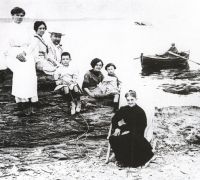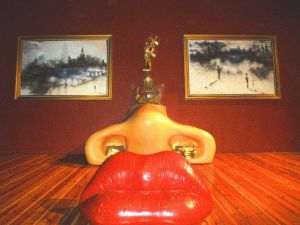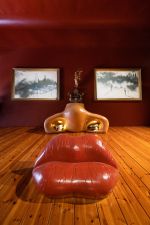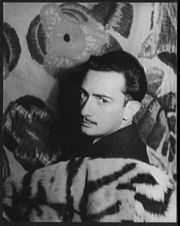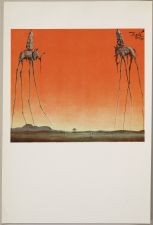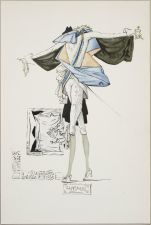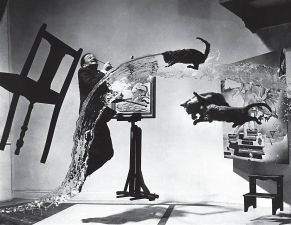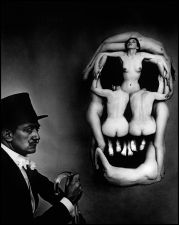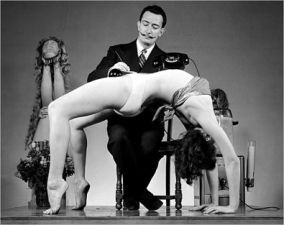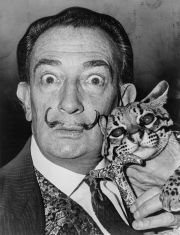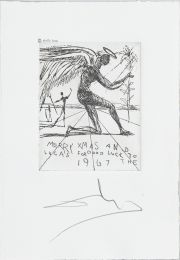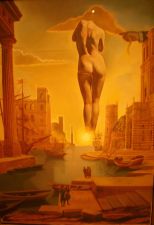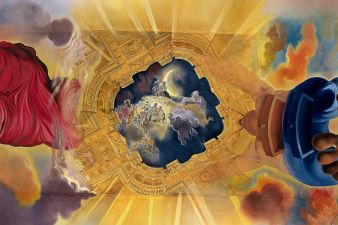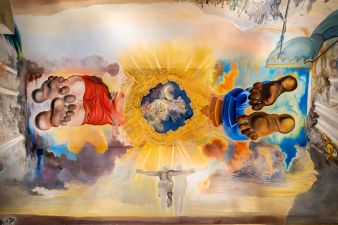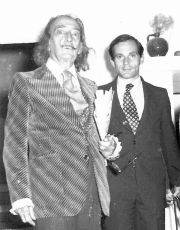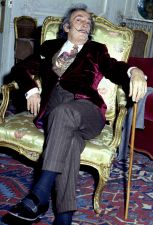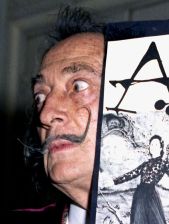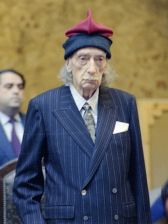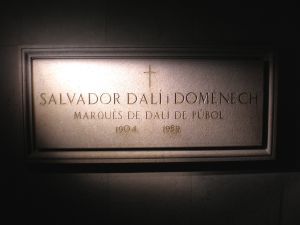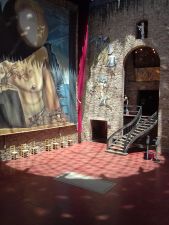Дали, Сальвадор
| Сальвадор Дали | |
|---|---|
| исп. Salvador Dalí | |
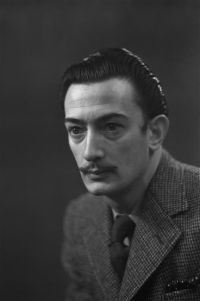 Сальвадор Дали, 1939 год | |
| Имя при рождении | Сальвадор Доменек Фелип Жасинт Дали и Доменек |
| Дата рождения | 11 мая 1904 |
| Место рождения | Фигерас, Каталония, Испания |
| Дата смерти | 23 января 1989 (84 года) |
| Место смерти | Фигерас, Каталония, Испания |
| Гражданство |
|
| Жанр | художник, живописец, график, скульптор, режиссёр |
| Учёба | Школа изящных искусств Сан-Фернандо, Мадрид |
| Стиль | сюрреализм, дадаизм, кубизм |
| Автограф |
|
Сальвадо́р Дали́ (кат. Salvador Domènec Felip Jacint Dalí i Domènech, Marqués de Dalí de Púbol, исп. Salvador Domingo Felipe Jacinto Dalí i Domènech[1]) — испанский живописец, график, скульптор, режиссёр и писатель, один из ведущих представителей сюрреализма. Родился 11 мая 1904 года в городе Фигерас, Каталония, Испания, дата смерти — 23 января 1989 года[2].
Художественный репертуар Дали включал живопись, графику, кино, скульптуру, дизайн и фотографию, также он писал художественную литературу, стихи, автобиографии, эссе и критические статьи[3]. Основными темами его работ выступают сны, подсознание, сексуальность, религия, наука и его личные переживания. Эксцентричное публичное поведение привлекало много общественного внимания, как и его работы[4]. Жизнь и творчество Дали оказали большое влияние на других сюрреалистов, художников поп-арта и современных художников, таких как Энди Уорхол, Джефф Кунс и Дэмиен Херст[5][6].
Биография
Рождение, семья и детство
Сальвадор Дали родился 11 мая 1904 года в городе Фигерас , в регионе Эмпорда , недалеко от французской границы в Каталонии, Испания. Спустя девять месяцев и десять дней после смерти своего брата от гастроэнтерита, которого также звали Сальвадор (родился 12 октября 1901 г.)
Второй ребенок в семье был назван Сальвадором не в честь умершего брата, а в честь предков — такова традиция в Каталонии и во всей Испании. Имя Фелипе было выбрано как мужской вариант имени матери, а Хасинто (Жасинт) — в честь отца, чье полное имя Рафаэль Нарсисо Хасинто.
Двадцатого мая он был крещен под именем Сальвадора Фелипе Хасинто в местной церкви Святого Петра. Крестным отцом стал его дядя, Ансельмо Доменеч, барселонский книготорговец, а крестной матерью — Тереза Куси, его бабушка с материнской стороны[4].
Отец будущего художника Рафаэль Анисето Дали Куси (1872–1950) был юрист и нотариус из среднего класса, мать Фелипа Доменек Феррес (1874–1921)[2][7].
Противоречивые методы воспитания: более строгие у отца и вседозволяющие у матери, воздействовали на капризный и своенравный характер. В пять лет Сальвадору становится известно об умершем брате, что оказывает сильное влияние на психику ребенка. Сальвадору было неприятно осознавать, что он второй ребенок в семье, ему разонравилось красивое имя, он стал бояться смерти, ассоциируя себя с братом, позже в воспоминаниях он пишет:
Мы были похожи с братом как две капли воды: та же печать гениальности, то же выражение беспричинной тревоги. Мы различались некоторыми психологическими чертами. Да еще взгляд у него был другой — как бы окутанный меланхолией, "неодолимой" задумчивостьюСальвадор Дали
Третьим ребенком в семье родилась девочка Анна Мария Дали (1908 — 1989)[2] (Ana Maria Dali), которая стала для Сальвадора Дали одним из лучших друзей детства, а впоследствии она позировала для многих его работ.
Бабушка Мария Анна Феррес со своей дочерью Каталиной переехали к Дали в 1910 году, когда Сальвадору было шесть лет, а Анне Марии два года, и заняли несколько комнат на верхнем этаже.
У Сальвадора и Анны Марии была няня Лусия Жисперт де Монтканут, чье большое влияние на их становление оба упоминают в своих мемуарах[4].
Тяга к творчеству проявилась у Дали достаточно в юном возрасте: с четырех лет года он со старанием пытался рисовать. Первую свою картину Сальвадор Дали нарисовал, когда ему было 10 лет - небольшой импрессионистский пейзаж, написанный на деревянной доске масляными красками. Дали целыми днями просиживал в маленькой, специально выделенной ему комнате рисуя картины.
Обучение и юность
Отец Дали определяет сына в старшие классы осенью 1916 года, одновременно записывая его в католический Коллеж братьев Марист. Предметы в школе и коллеже совпадали, темы уроков дублировались, но помимо этого дети получали некоторое религиозное образование, присутствуя на ранних утренних службах и слушая проповеди. Двойная система образования широко практиковалась в Испании и была популярна в семьях среднего класса, готовящих сыновей к поступлению в университет.
Школьная жизнь, дружественные контакты с одноклассниками сложно давались эмоциональному ребенку, страдающему разного рода фобиями, например, страхом перед кузнечиками, что мешало вести обычную жизнь в коллективе. Юноша привлекал внимание эпатажным, непослушным, странным поведением, всегда поступал вопреки чужим мнениям, без причины затевал драки.
Изобразительному искусству Дали начал обучаться в вечерней муниципальной художественной школе, где преподавал Хуан Нуньес Фернандес (1877-1963). За 6 лет Нуньес обучил своего ученика всему, что умел, и впоследствии Дали писал, что очень уважал своего наставника[4].
Проводя летние каникулы в курортном городке Кадакес во время игр в футбол его друзьями детства становятся будущие футболисты ФК «Барселона» Эмили Саги-Барба и Хосеп Самитьер. Тогда же, общаясь с семьей Пичот, юный художник открывает для себя современную живопись, знакомясь с работами художника Рамона Пичота, регулярно посещающего Париж. Из воспоминаний Сальвадора Дали:
...я открывал для себя французский импрессионизм, ставший самой значимой художественной школой в моей жизни. Это была первая встреча с антиакадемической и революционной эстетикой. Я всматривался в густые и беспорядочные мазки красок, создававшие на полотне причудливые пятна. Отойдя на некоторое расстояние и слегка наклонив голову, я прищуривался, и вдруг происходило необъяснимое чудо — цветовой хаос превращался в точное повторение реальности. Еще мгновение — и я обнаруживал на картине и воздух, и пространство, и сверкание красок!..
...Но больше всего я восхищался картинами, в которых импрессионизм переходил в откровенные приемы пуантилизма. Постоянное сопоставление оранжевого и фиолетового цветов создавало во мне радостное ощущение чего-то иллюзорного, я будто бы смотрел на предметы через призму и видел все в радужных переливах.
Темой большинства ранних работ были пейзажи в окрестностях Фигераса и Кадакеса. Другим раздольем для фантазии Дали были руины римского города вблизи Ампуриуса. Любовь к своим родным местам прослеживается во многих работах Дали. В 1917 или 1918 году художник написал портрет няни Лусии.
В 14 лет состоялась его первая первая официальная выставка совместно с двумя другими художниками Фигераса в муниципальном театре Принципаль. Юный Дали упорно ищет свой собственный почерк, а пока осваивает все нравившиеся ему стили: импрессионизм, кубизм, пуантилизм, говоря о себе в третьем лице:
Он рисовал страстно и жадно, как одержимый
В 1919 году в самодельном издании "Студиум" публикуются очерки о Веласкесе, Гойе, Эль Греко, Микеланджело и Леонардо, таким образом, авторства Дали, таким образом он стал излагать свои мысли на бумаге, живопись и литература оказались в равной мере частями его творческой жизни.
В начале 1921 года семья Пичот познакомила Дали с футуризмом , а дядя Дали Ансельм Доменек, владевший книжным магазином в Барселоне, снабжал его книгами и журналами по кубизму и современному искусству.
6 февраля 1921 года мать Дали на 47 году жизни умирает от рака. Дали было 16 лет, и позже он сказал, что смерть его матери «была величайшим ударом, который я испытал в своей жизни. Я боготворил ее…
После смерти жены отец Дали женился на её сестре. Дали не возмущался этим браком, потому что он очень любил и уважал свою тетю.
Творческие этапы
Раннее творчество
В 1921 году он поступает в Академию Сан-Фернандо (Real Academia de Bellas Artes de San Fernando).
В 1922 году Дали переезжает в «Резиденцию» (исп. Residencia de Estudiantes), студенческое общежитие в Мадриде для одарённых молодых людей, и начинает учёбу[8]. В это время Дали сближается с Луисом Бунюэлем, Федерико Гарсиа Лоркой, Педро Гарфиасом и другими, связанными с мадридской авангардной группой Ultra, через которых познакомился с авангардными движениями, включая дадаизм и футуризм . С увлечением читает работы Фрейда.
Дружеские отношения Дали с Лоркой стали эмоционально интенсивным моментом вплоть до смерти поэта в 1936 году. Частично сохранилась переписка между друзьями, большинство сведений было утеряно во время Гражданской войны, что затрудняет воссоздание процесса развития этой дружбы[9].
В 1923 году Дали как зачинщика студенческих беспорядков на год исключают из академии, и 35 дней он проводит в тюрьме.
В мае 1925 года Дали представил одиннадцать работ на групповой выставке, организованной недавно созданным Sociedad Ibérica de Artistas в Мадриде[10]. Семь работ были выполнены в его кубистическом стиле, а четыре - в более реалистичном стиле, несколько ведущих критиков высоко оценили эти работы[11]. Дали провел свою первую персональную выставку в Galeries Dalmau в Барселоне с 14 по 27 ноября 1925 года, эта выставка включала двадцать две работы и имела критический и коммерческий успех.
В 1926 году Дали окончательно исключили из академии за то, что он подстрекал однокашников протестовать против назначения одного посредственного живописца на профессорскую должность. После этого молодой художник уехал в Кадакес. В том же году появляется одно из наиболее известных ранних произведений мастера – натюрморт «Корзинка с хлебом», написанный для Гарсиа Лорки. Дали демонстрирует безукоризненное владение рисунком, цветом, пространством.
С февраля по октябрь 1927 года Сальвадор служит в армии. Он публикует поэму в прозе «Св. Себастьян» и разрабатывает эстетическую теорию «Священной объективности».
В начале 1927 года он провел неделю в столице Франции, где посещает Версаль, Музей Гревен и знакомится с Пабло Пикассо. В конце 20-х годов создаёт ряд работ под влиянием Пикассо и Жоана Миро[10].
Сюрреализм
Дали примыкает к сюрреализму, направлению в искусстве, где делается попытка выразить действительное движение мысли словами, рисунком или любым другим способом. Первые сюрреалистические работы Дали – «Кровь слаще меда», «Великолепие руки», «Раскрашенные удовольствия» – датируются 1928 годом[10].
В 1928 году Дали пробует себя в кинематографе: совместно с Бунюэлем он делает два фильма – «Андалузский пёс»[12] (1928) и «Золотой век» (1930).
Между тем отношения Дали с отцом были близки к разрыву. Дон Сальвадор Дали-и-Куси категорически не одобрял роман своего сына с Галой и изменил завещание, в котором исключал сына из наследников. 28 декабря 1929 года его насильно выгнали из отцовского дома.
В 1929 году после раскола сюрреалистов Дали становится главой нового центра и организует свою первую выставку в Париже[11]. Летом этого же года он впервые встречает Галу (Елену Дмитриевну Дьяконову). Она старше Дали на 10 лет и является женой поэта Поля Элюара. Гала сближается с Сальвадором, но продолжает встречаться со своим мужем, заводит свободные отношения с другими поэтами и художниками.
В 1930 году художник начинает разрабатывать свой «параноидно-критический метод, в качестве синтеза, где визионерская живопись выступает синтезом, который сплавляет реальность и сон, человека и природу, так что каждый образ может скрывать в себе другой образ. Андре Бретон пишет:
Дали подарил сюрреализму инструмент первого порядка, в данном случае параноико-критический метод, который, как он показал, можно применять одинаково в живописи, поэзии, кино, конструировании сюрреалистических объектов, моде, скульптуре, истории искусств и, в случае надобности, в любого рода экзегезе
Гала становится своеобразным импресарио Сальвадора Дали. В 1934 году официально вступает в брак с Галой[13]. В том же году впервые посещает США[14].
В середине 1920-х Дали отрастил аккуратно подстриженные усы. В последующие десятилетия он культивировал более яркие усы в манере испанского художника 17-го века Диего Веласкеса , и эти усы стали известной иконой Дали[15].
После начала гражданской войны в Испании в 1936 году Дали, являясь аполитичным, ссорится с сюрреалистами, стоящими на левых позициях, и его исключают из группы, на что Дали возразил:
Разница между сюрреалистами и мной в том, что я сюрреалист
В 1936 году Дали принял участие в Лондонской международной выставке сюрреалистов[11].
Его лекция под названием «Подлинные параноики Фантомов» была прочитана в гидрокостюме и шлеме для глубоководных погружений. Он прибыл с бильярдным кием и вел пару русских волкодавов, и ему пришлось отвинтить шлем, когда он незапланированно начал задыхался.
В том же году в галерее Alex, Reid and Lefevre прошла первая персональная выставка Дали в Лондоне. На выставке было представлено двадцать девять картин и восемнадцать рисунков. Критик Daily Telegraph писал:
Эти картины из подсознания раскрывают настолько искусного мастера, что возвращения художника в полное сознание можно ожидать с интересом
В декабре 1936 года Дали принял участие в выставке «Фантастическое искусство, дадаизм, сюрреализм» в Музее современного искусства и в персональной выставке в галерее Жюльена Леви в Нью-Йорке. Обе выставки привлекли большое количество посетителей и широкое освещение в прессе[11]. Особое внимание привлекла картина «Мягкая конструкция с вареной фасолью (Предчувствие гражданской войны)» (1936)[16]. Позже Дали описал это как «огромное человеческое тело, разбивающееся на чудовищные разрастания рук и ног, рвущих друг друга в бреду самоудушения». 14 декабря 32-летний Дали появился на обложке журнала Time .
В 1937 году художник посещает Италию и остаётся в восторге от произведений Ренессанса. Его творчество эволюционирует: в работах начинает доминировать правильность человеческих пропорций и другие черты академизма. Невзирая на отход от сюрреализма, его картины по-прежнему наполнены сюрреалистическими фантазиями.
В 1939 году Андре Бретон, насмехаясь над Дали и коммерческой составляющей его творчества, придумал ему прозвище-анаграмму «Avida Dollars», что с латыни созвучно как «алчный до долларов». Шутка Бретона мгновенно приобрела огромную популярность, но не повредила успеху Дали, который намного превосходил коммерческий успех Бретона.
Жизнь и творческие вехи в США
Первый визит Дали в Соединенные Штаты в ноябре 1934 года вызвал широкое освещение в прессе. Его вторая выставка в Нью-Йорке прошла в галерее Жюльена Леви в ноябре – декабре 1934 года и снова имела коммерческий успех и успех у критиков[11].
Дали прочитал три лекции о сюрреализме в Музее современного искусства (MoMA) и на других площадках, во время которых он впервые сказал своей аудитории, что «единственная разница между мной и сумасшедшим заключается в том, что я не сумасшедший». Наследница Каресс Кросби, изобретатель бюстгальтера, организовала прощальный костюмированный бал для Дали 18 января 1935 года. Дали носил на груди стеклянный ящик с бюстгальтером, а Гала была одета как женщина, рожающая через голову.
На Всемирной выставке в Нью-Йорке 1939 года Дали представил свой сюрреалистический павильон «Сон о Венере», расположенный в зоне развлечений экспозиции[11]. На нем были представлены причудливые скульптуры, статуи, русалки и живые обнаженные модели в «костюмах» из свежих морепродуктов, событие, сфотографированное Хорстом П. Хорстом, Джорджем Платтом Лайнсом и Мюрреем Корманом. Дали был возмущен изменениями в его проектах, выступая против посредственностей, которые думали, что «женщина с рыбьим хвостом возможна, женщина с рыбьей головой невозможна».
С началом в сентябре 1939 года Второй мировой войны чета Дали оказалась во Франции, после немецкого вторжения им удалось бежать. Сначала они пересекли Португалию и впоследствии отплыли на экскамбионе из Лиссабона в Нью-Йорк. С 1940 по 1948 год они продолжают жить в США[17].
В 1942 году выпускаетавтобиографию «Тайная жизнь Сальвадора Дали». Его литературные опыты, как и художественные произведения, как правило, оказываются коммерчески успешными. Он сотрудничает с Уолтом Диснеем. Тот предлагает Дали испытать свой талант в кино, но предложенный Сальвадором проект сюрреалистического мультфильма «Destino»[18] был признан коммерчески нецелесообразным, и работа над ним была прекращена. Дали работал с режиссёром Альфредом Хичкоком и создавал декорации для сцены сна из фильма «Заворожённый». Тем не менее сцена вошла в фильм сокращённо из-за коммерческих соображений.
Зрелые годы
В 1948 году Дали и Гала вернулись в свой дом в Порт-Льигате, на побережье недалеко от Кадакеса, проводя зимы в Париже и Нью-Йорке.
В декабре 1949 года сестра Дали Анна Мария опубликовала книгу «Сальвадор Дали, увиденный его сестрой». Дали был возмущен отрывками, которые он считал унизительными по отношению к своей жене Гале, и разорвал отношения со своей семьей. Ана Мария заменяла мать совершенно беспомощному и непрактичному в жизни Дали, и была его единственной женской моделью до того момента, когда он встретил Галу Элюар. Гала взяла роль единственной модели Дали на себя, чем вызвала непрекращающуюся враждебность Анны Марии.
Когда отец Дали умер в сентябре 1950 года, Дали узнал, что по завещанию он был фактически лишен наследства. Последовал двухлетний судебный спор по поводу картин и рисунков, которые Дали оставил в доме своей семьи, в ходе которого Дали был обвинен в нападении на государственного нотариуса. По мере того, как Дали продвигался дальше к принятию католицизма, он вводил в свои картины больше религиозной иконографии и тем. В 1949 году он написал этюд к «Мадонне Порт-Льигат» (первая версия, 1949) и показал его Папе Пию XII во время аудиенции, организованной для обсуждения брака Дали с Галой. Эта работа была предшественницей фазы, которую Дали назвал «ядерным мистицизмом», сплавом эйнштейновской физики, классицизма и католического мистицизма[10]. В таких картинах, как «Мадонна Порт-Льигата» , «Христос святого Иоанна на кресте» и «Распад постоянства памяти»[16], Дали стремился синтезировать христианскую иконографию с образами материального распада, вдохновленными ядерной физикой. Его более поздние работы по ядерному мистицизму включали «Вокзал Перпиньян» (1965) и «Галлюциногенный тореадор» (1968–70)[10][16].Острый интерес Дали к естествознанию и математике еще больше проявился в распространении изображений ДНК и форм рогов носорога в работах середины 1950-х годов. Согласно Дали, рог носорога означает божественную геометрию, потому что он растет по логарифмической спирали. Дали также был очарован Тессерактом (четырехмерным кубом), используя его, например, в «Распятии» (Corpus Hypercubus)[16].
Дали широко использовал оптические иллюзии, такие как двойные изображения, анаморфозы , негативное пространство , визуальные каламбуры и trompe-l'œil, начиная с периода сюрреализма, и это продолжалось в его более поздних работах[10]. В какой-то момент Дали установил стеклянный пол в комнате возле своей студии в Порт-Льигате. Он широко использовал его для изучения ракурса как сверху, так и снизу, включая в свои картины драматические перспективы фигур и предметов. Он также экспериментировал с пуантилизмом , увеличенными полутоновыми точечными сетками и стереоскопическими изображениями. Он был одним из первых художников, применивших голографию в художественной манере[19].
В 1960 году Дали начал работу над своим Театром-музеем в своем родном городе Фигерас[20]. Это был его самый крупный проект, и он был основным направлением его энергии до 1974 года, когда он открылся. Он продолжал вносить дополнения до середины 1980-х годов.
В 1965 году Дали приехал в Париж и покорил его своими работами, выставками и эпатажными поступками, во французском ночном клубе познакомится с Амандой Лир , фотомоделью, тогда известной как Пеки Осло, которая становится его протеже и одной из его муз.
Снимает короткометражные фильмы, делает сюрреалистические фотографии. В фильмах он использует в основном эффекты обратного просмотра, но умело подобранные объекты съёмки (льющаяся вода, мяч, скачущий по ступенькам), интересные комментарии, таинственная атмосфера, созданная актёрской игрой художника, делает фильмы необычными образцами арт-хауса. Дали снимается в рекламе шоколада, в которой художник откусывает кусочек плитки, после чего у него от эйфорического восторга закручиваются усы, и он восклицает, что сошёл с ума от этого шоколада.
Последние годы жизни и смерть
В 1968 году Дали купил для Галы замок Пуболь, в котором она жила отдельно от мужа, и который он сам мог посещать лишь по письменному разрешению супруги[21].
В 1980 году, в возрасте 76 лет, здоровье Дали резко ухудшилось, и его лечили от депрессии, наркомании и симптомов, подобных болезни Паркинсона, включая сильный тремор правой руки.
Гала умерла 10 июня 1982 года в возрасте 87 лет. После её смерти Дали переехал из Фигераса в замок Пуболь, где она была погребена.
В 1982 году король Хуан Карлос даровал Дали титул маркиза де Дали де Пуболь ( маркиз Дали де Пуболь ) в дворянстве Испании, Пуболь был местом, где тогда жил Дали. Первоначально титул был наследственным, но по просьбе Дали был изменен на пожизненный в 1983 году
В мае 1983 года была показана последняя картина Дали «Ласточкин хвост»[16][10]. На работу сильно повлияла математическая теория катастроф Рене Тома . Однако некоторые критики задаются вопросом, как Дали мог написать картину с такой точностью, учитывая сильную дрожь в его рисующей руке.
С начала 1984 года депрессия Дали усилилась, и он отказался от еды, что привело к тяжелому недоеданию. Ранее Дали заявлял о своем намерении ввести себя в состояние анабиоза, поскольку он читал, что это могут делать некоторые микроорганизмы.
В августе 1984 года в спальне Дали вспыхнул пожар, и он был госпитализирован с тяжелыми ожогами. Два судебных расследования установили, что пожар был вызван неисправностью в электросети, и не было сделано никаких выводов о халатности. После выписки из больницы Дали переехал в Торре Галатея, пристройку к Театру-музею Дали.
В июле 1986 года Дали имплантировали кардиостимулятор. По возвращении в свой Театр-музей он ненадолго выступил перед публикой, сказав:
Когда ты гений, ты не имеешь права умереть, потому что мы необходимы для прогресса человечества
В ноябре 1988 года Дали попал в больницу с сердечной недостаточностью. 5 декабря 1988 года его посетил король Хуан Карлос, который признался, что всегда был серьезным поклонником Дали. Дали подарил королю рисунок «Голова Европы », который стал последним рисунком Дали.
Утром 23 января 1989 года Дали умер от сердечного приступа в возрасте 84 лет. Последней волей Сальвадор потребовал, чтобы его похоронили в таком месте, чтобы по нему ходили люди. Воля была исполнена, и его тело было замуровано в пол музея Дали в городе Фигерас, Испания.Он похоронен в склепе под сценой своего Театра-музея в Фигерасе[20]. Место находится через дорогу от церкви Сант-Пере , где он принял крещение , первое причастие и похороны.
Фонд Гала-Сальвадора Дали в настоящее время служит его официальным имуществом. Уполномоченным по авторским правам Фонда Гала-Сальвадора Дали в США является Общество прав художников .
Наследие
Музеи
- Театр-музей Дали в Фигерасе[20]
- La maison-musée Salvador Dali (Portlligat, Espagne)
- Salvador Dalí Museum, St. Petersburg, Florida[17]
Автобиографии
Реклама и дизайн
Перечень картин
1910—1919
- 1910 Landscape Near Figueras, 1910
- 1913 Vilabertrin, 1913
- 1914 Dutch Interior, 1914
- 1914 Fiesta in Figueres, 1914-16
- 1914 Head of Athene, 1914
- 1914 Landscape Near Ampurdan, 1914
- 1914 Untitled, 1914
- 1914 Untitled — House by a Lake, 1914
- 1916 Landscape, 1916
- 1916 Landscape, 1916
- 1916 Untitled — Landscape with Animals, 1916
- 1916 Witches and the Fall of Eve, 1916-18
- 1917 Cadaqués, 1917
- 1917 Cadaqués, 1917-18
- 1917 Crepuscular Old Man, 1917-18
- 1917 View of Cadaqués with Shadow of Mount Pani, 1917
- 1918 Bathers, 1918-19
- 1918 Boat, 1918
- 1918 Couple Near the Fortress, 1918
- 1918 Duck, 1918
- 1918 Hort del Llane, 1918-19
- 1918 Playa Port Alguer De La Riba, D’en Pitxot, 1918-19
- 1918 Playa Port Alguer from Riba d’en Pitxot, 1918-19
- 1918 Port of Cadaqués (Night), 1918-19
- 1918 Portdogué, 1918-19
- 1918 Portrait of Lucia (Retrato de Lucia), 1918
- 1918 Punta es Baluard de la Riba d’en Pitxot, 1918-19
- 1918 Sea View, 1918-19
- 1918 Still Life, 1918
- 1918 Untitled, 1918
- 1918 Vilabertrin Church Tower, 1918-19
- 1919 Es Pianc, 1919
- 1919 Es Poal — Pianque, 1919-20
- 1919 Evening Ball at the Patio of Mariona, 1919
- 1919 Landscape (Cadaqués), 1919-20
- 1919 Llané Beach, Cadaqués, 1919
- 1919 My Cousin Montserrat, 1919-20
- 1919 Old Man of Portdogué, 1919-20
- 1919 Orchard at Llané (Cadaqués), 1919-20
- 1919 Port Dogué — Cadaqués, 1919
- 1919 The Port of Cadaqués, 1919
- 1919 Portrait of a Gipsy, 1919
- 1919 Portrait of Hortensia, Peasant Woman of Cadaqués, 1919
- 1919 Portrait of Joaquim Montaner (Allegory of a Sailor), 1919-20
- 1919 Portrait of Mr. Pancraci, 1919
- 1919 Sailboat with Figure. Study for the Boat in «El Son», 1919
- 1919 Self-Portrait in the Studio, 1919
- 1919 Still Life: Pomegranates, 1919
- 1919 The Tartan «El Son», 1919
- 1919 The Three Pines, 1919
1920—1929
- 1920 The Artist’s Father at Llane Beach, 1920
- 1920 The Bay at Cadaqués, with Cucurucuc Rock and the Sorrell, Peninsula, 1920
- 1920 Boxer, 1920
- 1920 Calanque Jonculs (Cadaqués), 1920
- 1920 The Garden of Llaner (Cadaqués), 1920-21
- 1920 Grandmother Ana Sewing, 1920
- 1920 The Lake at Vilabertran, 1920
- 1920 Landscape (Cadaqués), 1920
- 1920 Landscape Near Cadaqués, 1920-21
- 1920 Landscape Near Cadaqués, 1920-21
- 1920 Moonlight Over the Bay At, Cadaqués, 1920
- 1920 Mother, 1920
- 1920 Portrait of the Artist’s Mother, Dofia Felipa Dome Domenech De, Dalí, 1920
- 1920 Portrait of the Violoncellist Ricardo Pichot, 1920
- 1920 Portrait of Jose M. Torres, 1920
- 1920 Saltimbanques, 1920-21
- 1920 The Sardana of the Witches, 1920
- 1920 Satirical Portrait of Trotsky, 1920
- 1920 Small Rocky Bay of Nans (Cadaqués), 1920-21
- 1920 Still Life, 1920
- 1920 Still Life by a Window, 1920
- 1920 Studies for a Self-Portrait and Portrait of My Father, 1920
- 1920 Study for Portrait of My Father, 1920
- 1920 Study for «My Family», 1920
- 1920 Study for a Self-Portrait, 1920
- 1920 Tieta, 1920
- 1920 Two Gypsy Lads, 1920-21
- 1920 Two Studies for Portrait of My Father, 1920
- 1920 Untitled — the Artist in His Studio in Riba D’en Pitxot in Cadaqués, 1920-21
- 1920 The Vegetable Garden of Llaner, 1920
- 1920 View of Cadaqués from Playa Poal, 1920
- 1920 View of Portdogué (Port Aluger), 1920
- 1921 Back View of Cadaqués, 1921
- 1921 Cover of «Per La Musica, Poems», 1921
- 1921 Fair of the Holy Cross — The Circus, 1921
- 1921 Festival at San Sebastian, 1921
- 1921 Festival in Figueras, 1921
- 1921 Festival of St. Lucia At, Villamalla, 1921
- 1921 Landscape Near Cadaqués, 1921
- 1921 Llaner Beach in Cadaqués, 1921
- 1921 Man Holding Up a Baby as Though He Were Drinking from a Bottle, 1921
- 1921 Man with Porron, 1921
- 1921 Moonlight at Little Llané, 1921
- 1921 Motherhood, 1921
- 1921 Muse of Cadaqués, 1921
- 1921 Nymphs in a Romantic, Garden, 1921
- 1921 The Picnic, 1921
- 1921 Portrait of Grandmother Ana Sewing, 1921
- 1921 Portrait of Jaume Miravidles as a Footballer, 1921-22
- 1921 Portrait of My Father, 1921
- 1921 Portrait Ofjaume Miravidles, 1921-22
- 1921 Poster: Fieres i Festes de la Santa Creu, 1921
- 1921 Romeria — Pilgrimage, 1921
- 1921 Rural Scene, 1921
- 1921 A Seated Man and a Dancing Couple, 1921
- 1921 Self-portrait, 1921
- 1921 Self-Portrait, 1921
- 1921 Self-portrait, 1921
- 1921 Self-portrait (Figueres), 1921
- 1921 Self-portrait with the Neck of Raphael, 1921
- 1921 Still Life for the Cover of «Per La, Musica, Poems», 1921
- 1921 Title Page of the Magazine 'Empordá Federal' and Title Design for «Biografia d’en Pep Ventura», 1921
- 1921 Voyeur, 1921
- 1921 Young Girls in a Garden, 1921
- 1922 Brothels, 1922
- 1922 Cabaret Scene, 1922
- 1922 Cadaqués, 1922
- 1922 Cubist Composition (Shapes), 1922
- 1922 Cubist Composition — Still Life with Guitar, 1922
- 1922 Drinker, 1922
- 1922 Female Figure with Head in Arms, 1922
- 1922 The First Days of Spring, 1922-23
- 1922 Fishermen at Cadaqués, 1922
- 1922 Fishing Folk at Cadaqués, 1922
- 1922 Horse, 1922
- 1922 Jug, 1922-23
- 1922 Landscape — Cadaqués, 1922
- 1922 The Lane to Port Lligat with the View of Cape Creus, 1922-23
- 1922 Madrid, Architecture and Poplars, 1922
- 1922 Portdogué and Mount Pani from Ayuntamiento, 1922
- 1922 Seated Woman, 1922
- 1922 Self-Portrait, 1922
- 1922 Still Life, 1922
- 1922 Still Life, 1922
- 1922 Still Life, 1922
- 1922 Still Life (Pulpo y scorpa), 1922
- 1922 Still Life — Fish, 1922
- 1922 Still Life with Aubergines, 1922
- 1922 Still Life with Glass, 1922
- 1922 Study of a Foot, 1922
- 1922 Summer Night, 1922
- 1922 Untitled — Landscape Near, Madrid, 1922-23
- 1922 Untitled — Scene in a Cabaret in Madrid, 1922
- 1922 Villa Pepita, 1922
- 1923 All Shapes Derive from the Square, 1923
- 1923 Barracks (Cadaqués), 1923
- 1923 Bathers of La Costa Brava — Bathers of Llaner, 1923
- 1923 Cadaqués, 1923
- 1923 Cadaqués (Seen from the Tower of Creus), 1923
- 1923 Coffee House Scene in Madrid, 1923
- 1923 Crystalline Still Life, 1923
- 1923 Cubist Composition — Portrait of a Seated Person Holding a Letter, 1923
- 1923 Cubist Self-Portrait with «La Publicitat», 1923
- 1923 Domestic Scene, 1923
- 1923 El Moli — Landscape Near Cadaqués, 1923
- 1923 Figueras Gypsy, 1923
- 1923 Figures in a Landscape at Ampurdan, 1923
- 1923 Fried Egg on the Plate without the Plate, 1923
- 1923 Grandfather Clock, 1923
- 1923 Group of Young Catalan Girls, 1923
- 1923 Harlequin Sitting at a Table, 1923
- 1923 The Jorneta Stream, 1923
- 1923 La Jorneta, 1923
- 1923 Landscape Near Cadaqués, 1923
- 1923 Luis Buñuel and a Toreo, 1923-24
- 1923 Maternity, 1923
- 1923 Nude in a Landscape, 1923
- 1923 Portrait of My Cousin Ana, Maria Domenech, 1923
- 1923 Portrait of My First Cousin, 1923
- 1923 Portrait of My Sister (original State), 1923-24
- 1923 Reverse Side of «Study of a Nude», 1923
- 1923 Satirical Composition («The Dance» by Matisse), 1923
- 1923 Self-Portrait, 1923
- 1923 Self-portrait with L’Humanitie, 1923
- 1923 The Sick Child (Self-portrait in Cadaqués), 1923
- 1923 Still Life, 1923
- 1923 Still Life, 1923
- 1923 Still Life: Fish with Red Bowl, 1923-24
- 1923 Study for «Woman with a Child», 1923
- 1923 Study of a Nude, 1923
- 1923 Venus and Memory of Avino, 1923-24
- 1923 Woman Nursing Her Son (Mujer amamantando a su hijo), 1923
- 1924 Ana Maria, 1924
- 1924 Bather, 1924
- 1924 Bouquet (L’Important c’est la Rose), 1924
- 1924 Head of a Man with a Child, 1924-25
- 1924 Pierrot and Guitar, 1924
- 1924 Plant, 1924
- 1924 Port Alguer, 1924
- 1924 Portrait of Ana Maria, 1924
- 1924 Portrait of Luis Bunuel, 1924
- 1924 Portrait of Manuel de Falla, 1924-25
- 1924 Portrait of a Woman, 1924
- 1924 Siphon and Small Bottle of Rum, 1924
- 1924 The Station at Figueras, 1924
- 1924 Still Life, 1924
- 1924 Still Life, 1924
- 1924 Still Life, 1924
- 1924 Still Life: Watermelon, 1924
- 1924 Triple Portrait of García Lorca, 1924
- 1925 Bay of Cadaqués, 1925
- 1925 Cala Nans, 1925
- 1925 Don Salvador and Ana Maria Dalí (Portrait of the Artist’s Father and Sister), 1925
- 1925 Double-sided Verso (Studio Scene), 1925
- 1925 Female Nude, 1925
- 1925 Figure at a Window, 1925
- 1925 Girl from the Back, 1925
- 1925 Girl Reclining on a Bed (Ana-Maria Dalí), 1925
- 1925 Landscape Near Ampurdan, 1925
- 1925 Landscape Near Ampurdan, 1925
- 1925 Nude in the Water, 1925
- 1925 Pierrot Playing the Guitar, 1925
- 1925 Port Alguer, 1925
- 1925 Portrait of the Artist’s Father, 1925
- 1925 Portrait of the Artist’s Father and Sister, 1925
- 1925 Portrait of Ana Maria (Cadaqués), 1925
- 1925 Portrait of Maria Carbona, 1925
- 1925 Portrait of Maria Carbona, 1925
- 1925 Purist Drawing, 1925
- 1925 Seated Monk, 1925
- 1925 Self-portrait Dedicated to Frederico, 1925
- 1925 Still Life, 1925
- 1925 Still Life with Moonight, 1925
- 1925 Study for «Venus and Sailor», 1925
- 1925 Study of Nude, 1925
- 1925 Thought, 1925
- 1925 Venus and a Sailor (1), 1925
- 1925 Venus and a Sailor (2), 1925
- 1925 Venus and a Sailor — (Homage to Salvat-Papasseit), 1925
- 1925 Venus with Cupids, 1925
- 1925 Venus with Cupids (detail), 1925
- 1926 Abstract Composition, 1926
- 1926 Ana Maria, Sewing, 1926
- 1926 The Basket of Bread, 1926
- 1926 Cubist Figure (Figura cubista), 1926
- 1926 Female Nude, 1926
- 1926 Femme Couchée (Nu Alongé), 1926
- 1926 Figure on the Rocks (Figura damunt les roques), 1926
- 1926 Figure on the Rocks (Penya Segats), 1926
- 1926 The Girl — Study for «The Girl of Ampurdan», 1926
- 1926 The Girl of Figueras, 1926
- 1926 Girl Sewing, 1926
- 1926 Girl with Curls, 1926
- 1926 Girl’s Back, 1926
- 1926 Homage to Erik Satie, 1926
- 1926 Neo-Cubist Academy (Composition with Three Figures), 1926
- 1926 Portrait of Federico García Lorca, 1926-27
- 1926 Portrait of a Girl in a Landscape (Cadaqués), 1926
- 1926 Portrait of Sefiora Abadal De’Argemi, 1926
- 1926 Portrait of a Woman, (unfinished), 1926
- 1926 Rocks at Llane (Landscape near Cadaqués), 1926
- 1926 Rocks of Llané (first version), 1926
- 1926 Sailor and His Family, 1926
- 1926 Self-Portrait Being Duplicated into Three, 1926-27
- 1926 Still Life with Two Lemons, 1926
- 1926 Study for Girl Sewing, 1926
- 1926 Study for «Ana Maria». Cover of the Catalogue for Dalí's Second Exhibition at the Dalmau Gallery in Barcelona, 1926
- 1926 Study for «Blood Is Sweeter Than Honey», 1926
- 1926 Study for «Girl Sewing», 1926
- 1926 Study for «Girl Sewing», 1926
- 1926 Study for «Girl Sewing» (2), 1926
- 1926 Venus and Sailor (Girl and Sailor; Unfinished), 1926
- 1926 Woman in a Chemise, Lying, (Study for «Women Lying on the Beach»), 1926
- 1926 Women Lying on the Beach, 1926
- 1927 Apparatus and Hand, 1927
- 1927 Automatic Drawing (Untitled), 1927
- 1927 Barcelonese Mannequin, 1927
- 1927 Figure Edged in Flames, 1927
- 1927 Harlequin, 1927
- 1927 Head (Draft of a Double Image), 1927
- 1927 Head of a Woman, 1927
- 1927 Honey Is Sweeter Than Blood, 1927
- 1927 Nude Woman in an Armchair, 1927
- 1927 Ocell… Peix, 1927-28
- 1927 The Poet on the Beach of Ampurias — Federico Garcia Lorca, 1927
- 1927 Saint Sebastian, 1927
- 1927 The Severed Hand, 1927-28
- 1927 Still Life by the Light of the Moon, 1927
- 1927 Study for «Still Life by the Light of the Moon», 1927
- 1927 Untitled, 1927
- 1928 Abstract Composition, 1928
- 1928 Anthropomorphic Beach (first state), 1928
- 1928 Anthropomorphic Beach (fragment), 1928
- 1928 Bather, 1928
- 1928 The Bather (Beigneuse), 1928
- 1928 Big Thumb, 1928
- 1928 Bird, 1928
- 1928 Composition, 1928
- 1928 The Donkey’s Carcass, 1928
- 1928 Female Nude, 1928
- 1928 Feminine Nude (first State), 1928
- 1928 Fishermen in the Sun, 1928
- 1928 Fishermen in Cadaqués, 1928
- 1928 Little Cinders (Senicitas), 1928
- 1928 Moonlight, 1928
- 1928 The Ram (The Spectral Cow), 1928
- 1928 Rotting Bird, 1928
- 1928 Self-Portrait Dedicated to Federico Garcia Lorca, 1928
- 1928 Shell, 1928
- 1928 Soft Nude (Nude Watch), 1928
- 1928 The Spectral Cow, 1928
- 1928 Sun, 1928
- 1928 Surrealist Composition, 1928
- 1928 Symbiotic Woman-Animal, 1928
- 1928 Unsatisfied Desires, 1928
- 1928 Untitled, 1928
- 1928 Untitled, 1928
- 1928 Untitled, 1928
- 1928 Untitled (the Sea and the Fishermen), 1928
- 1928 The Wounded Bird, 1928
- 1929 Accomodations of Desire, 1929
- 1929 Amalgam — Sometimes I Spit on the Portrait of My Mother for the Fun of It, 1929
- 1929 Andre Breton, the Great Anteater, 1929-31
- 1929 The Butterfly Chase, 1929
- 1929 The Enigma of Desire: My Mother, 1929
- 1929 The First Days of Spring, 1929
- 1929 The Great Masturbator, 1929
- 1929 Illumined Pleasures, 1929
- 1929 Imperial Monument to the Child-Woman, 1929
- 1929 The Invisible Man, 1929
- 1929 The Invisible Man, 1929
- 1929 The Kiss — Study for the Couple Who Are Embracing in «The Great Masturbator», 1929
- 1929 Lugubrious Game, 1929
- 1929 Man with Unhealthy Complexion Listening to the Sound of the Sea (The Two Balconies), 1929
- 1929 Phantasmagoria, 1929
- 1929 Portrait of Paul Eluard, 1929
- 1929 Profanation of the Host, 1929
- 1929 Studies for «The Enigma of Desire» and «Memory of the Child-Woman», 1929
- 1929 Study for «the Enigma of Desire — My Mother, My Mother, My Mother», 1929
- 1929 Study for «The Great Masturbator», 1929
- 1929 Study for «The Lugubrious Game», 1929
- 1929 Study for «Invisible Sleeping Woman, Horse, Lion» and for «Paranoiac Woman-Horse», 1929-30
1930—1939
- 1930 Andromeda, 1930
- 1930 The Average Bureaucrat, 1930
- 1930 The Bleeding Roses, 1930
- 1930 Chocolate, 1930
- 1930 Consequences: Dalí, Gala Eluard, Valentine Hugo, Andre Breton, 1930
- 1930 The Feeling of Becoming, 1930
- 1930 The Font, 1930
- 1930 The Ghost of the Evening, 1930
- 1930 Gradiva (Study for «The Invisible Man»), 1930
- 1930 The Great Masturbator, 1930
- 1930 The Great Masturbator — Frontispiece for «The Visible Woman», 1930
- 1930 The Hand, 1930
- 1930 Head of Hair, 1930
- 1930 Invisible Sleeping Woman, 1930
- 1930 Invisible Sleeping Woman, 1930
- 1930 Oedipus Complex, 1930
- 1930 Paranoiac Woman-Horse, 1930
- 1930 Portrait of Mr. Emilio Terry (unfinished), 1930
- 1930 Premature Ossification of a Railway Station, 1930
- 1930 Pyre. Poster Design for the 10th Anniversary of the French Communist Party, 1930
- 1930 The Red Tower (Anthropomorphic Tower), 1930
- 1930 Study for «The Dream», 1930
- 1930 Study for «Invisible Sleeping Woman, Horse, Lion», 1930
- 1930 Study for «Invisible Sleeping Woman, Horse, Lion», 1930
- 1930 Tactile Cinema, 1930-31
- 1930 Untitled — Feminine Nude — Frontispiece of «La Femme Visible», 1930
- 1930 Vertigo, 1930
- 1930 William Tell, 1930
- 1931 Board of Demented Associations (Fireworks), 1931
- 1931 Combinations (or The Combined Dalínian Phantasms: Ants, Keys, Nails), 1931
- 1931 Diurnal Illusion: the Shadow of a Grand Piano Approaching, 1931
- 1931 The Dream, 1931
- 1931 Erotic Drawing, 1931
- 1931 Figure Clock, 1931
- 1931 Gradiva, 1931
- 1931 Gradiva Finds the Anthropomorphic Ruins, 1931
- 1931 Landscape, 1931
- 1931 Le Spectre et le Fantome, 1931
- 1931 Mme. Reese, 1931
- 1931 The Old Age of William Tell, 1931
- 1931 Olive, 1931
- 1931 On the Seashore, 1931
- 1931 Paranoiac Visage — Postcard Sent by Picasso to Dalí, 1931
- 1931 Partial Hallucination. Six apparitions of Lenin on a Grand Piano, 1931
- 1931 The Persistence of Memory, 1931
- 1931 Portrait of Gala, 1931
- 1931 Remorse or Sunken Sphinx, 1931
- 1931 Shades of Night Descending, 1931
- 1931 Solitude, 1931
- 1931 Symbiosis of a Head of Seashells, 1931
- 1931 Untided (William Tell and Gradiva), 1931
- 1931 Untitled, 1931
- 1931 Untitled — Erotic Drawing, 1931
- 1931 Vegetable Metamorphosis, 1931
- 1931 Woman Sleeping in a Landscape, 1931
- 1931 They Were There, 1931
- 1932 Agnostic Symbol, 1932
- 1932 Anthropomorphic Bread, 1932
- 1932 Anthropomorphic Bread, 1932
- 1932 Automatic Beginning of a Portrait of Gala (unfinished), 1932
- 1932 The Average Fine and Invisible Harp, 1932
- 1932 Babaouo, 1932
- 1932 Babaouo — Publicity Announcement for the Publication of the Scenario of the Film, 1932
- 1932 The Birth of Liquid Desires, 1932
- 1932 The Birth of Liquid Fears, 1932
- 1932 Detail of «Meditation on The Harp», 1932-34
- 1932 Diurnal Fantasies, 1932
- 1932 The Dream Approaches, 1932-33
- 1932 Eggs on the Plate Without the Plate, 1932
- 1932 Eggs on the Plate Without the Plate, 1932
- 1932 Figure Study for «William Tell», 1932
- 1932 Frontispiece for «Le Revolver Ii, Cheveux Blancs» by Andre Breton, 1932
- 1932 Gradiva, 1932
- 1932 The Invisible Man, 1932
- 1932 The Knight at the Tower, 1932
- 1932 The Meeting of the Illusion and the Arrested Moment — Fried Eggs Presented in a Spoon, 1932
- 1932 Memory of the Child-Woman, 1932
- 1932 The Mysterious Sources of Harmony, 1932-33
- 1932 Nostalgia of the Cannibal, 1932
- 1932 Ordinary French Loaf with Two Fried Eggs Riding Without a Plate, 1932
- 1932 Paranoaic Metamorphosis of Gala’s Face, 1932
- 1932 Phosphene of Laporte, 1932
- 1932 Portrait of the Viscountess Marie-Laure de Noailles, 1932
- 1932 Portrait of Gala, 1932-33
- 1932 Preliminary Study for «Portrait of Vicomtesse Marie-Laure Cle Noailles», 1932
- 1932 Studies for «Weaning of Furniture-Nutrition», 1932-33
- 1932 Study for the Nurse in «The Weaning of Furniture-Nutrition», 1932-33
- 1932 Study for «Large Painting», 1932
- 1932 Study for «Meditation on The Harp», 1932-33
- 1932 Study for «Memory of the Child-Woman», 1932
- 1932 Suez, 1932
- 1932 Surrealist Architecture, 1932
- 1932 Surrealist Essay, 1932
- 1932 Surrealist Object Gauge of Instantaneous Memory, 1932
- 1932 The True Painting of «The Isle of the Dead» by Arnold Bocklin at the Hour of the Angelus, 1932
- 1932 Untitled, 1932
- 1932 Untitled (Erotic Drawing), 1932
- 1932 Untitled — Cyclist with a Loaf of Bread on His Head, 1932
- 1932 Untitled — Female Figure with Catalonian Bread, 1932
- 1932 The Veiled Heart, 1932
- 1932 William Tell, Gradiva and The Average Bureaucrat, 1932
- 1933 Ambivalent Image, 1933
- 1933 Apparition of My Cousin Carolineta on the Beach at Rosas, 1933
- 1933 The Architectural Angelus of Millet, 1933
- 1933 Average Atmospherocepalic Bureaucrat in the Act of Milking a Cranial Harp, 1933
- 1933 Bureaucrat and Sewing Machine — Illustration for «Les Chants de Maldoror», 1933
- 1933 The Bust of a Retrospective Woman, 1933
- 1933 Cannibalism of Objects (inscribed: Meat Glass, Meat Aeroplane, Meat Spoon, Meat Watch, Meat Head), 1933
- 1933 Cannibalism. Illustrations for «Les Chants De Maldoror» by Lautreamont, 1933
- 1933 The Enigma of William Tell, 1933
- 1933 Flesh Aeroplane. Illustration for «Les Chants De Maldoror» by Lautreamont, 1933
- 1933 Gala and the Angelus of Millet Preceding the Imminent Arrival of the Conical Anamorphoses, 1933
- 1933 Geological Destiny, 1933
- 1933 Gradiva, 1933
- 1933 Illustration for Les Chants de Maldoror by the Count of Lautreamont, 1933-34
- 1933 The Judges, 1933
- 1933 Knight of Death (variant), 1933
- 1933 Myself at the Age of Ten When I Was the Grasshopper Child, 1933
- 1933 Necrophilic Fountain Flowing from a Grand Piano, 1933
- 1933 The Phantom Cart, 1933
- 1933 The Phantom Cart, 1933
- 1933 The Phenomenon of Ecstasy, 1933
- 1933 Portrait of Gala with Two Lamb Chops Balanced on Her Shoulder, 1933
- 1933 Reverie — Password: Mess Up, All the Slate, 1933
- 1933 Soft Watches, 1933
- 1933 Study for «The Enigma of William Tell», 1933
- 1933 Study for «Portrait of the Vicomtesse de Noailles», 1933
- 1933 Sugar Sphinx, 1933
- 1933 Sugar Sphinx (detail), 1933
- 1933 Surrealist Figure in the Landscape of Port Lligat, 1933
- 1933 Surrealist Figures, Joint Drawing by Dalí and Picasso, 1933
- 1933 Surrealist Horse — Woman-Horse, 1933
- 1933 The Temple of Love, 1933
- 1933 The Triangular Hour, 1933
- 1933 Two Faces of Gala, 1933-34
- 1933 Untitled, 1933-34
- 1933 Untitled (Study for Parts of «Invisible Harp, Fine and Medium» and Parts of «Skull with Its Lyric Appendage Leaning on a Bedside, Table…»), 1933
- 1933 Untitled — Death Outside the Head/Paul Eluard, 1933
- 1934 Aerodynamic Chair, 1934
- 1934 Allegory of an American Christmas, 1934
- 1934 Apparition of My Cousin Carolinetta on the Beach at Rosas, 1934
- 1934 Atavism at Twilight, 1934
- 1934 Atavistic Vestiges After the Rain, 1934
- 1934 Atmospheric Skull Sodomizing a Grand Piano, 1934
- 1934 Bust of Joella Lloyd, 1934
- 1934 Cannibalism of the Praying Mantis of Lautreamont, 1934
- 1934 Cardinal, 1934
- 1934 Conic Anamorphosis, 1934
- 1934 Consequences, 1934
- 1934 Consequences: Gala Eluard, Dalí, Andre Breton, Valentine Hugo, 1934
- 1934 Consequences: Gala Eluard, Valentine Hugo, Andre Breton, Dalí, 1934
- 1934 Consequences: Valentine Hugo, Andre Breton, Gala Eluard, Dalí, 1934
- 1934 Consequences: Valentine Hugo, Dalí, Andre Breton, Gala Eluard, 1934
- 1934 Eclipse and Vegetable Osmosis, 1934
- 1934 Enigmatic Elements in the Landscape, 1934
- 1934 Figure — Omelettes, 1934
- 1934 Figure and Drapery in a Landscape, 1934
- 1934 Figure with Drawers for a Four-part Screen, 1934
- 1934 Fossil Cloud, 1934
- 1934 The Ghost of Vermeer of Delft Which Can Be Used As a Table, 1934
- 1934 The Ghost of Vermeer van Delft, 1934
- 1934 Ghost of Vermeer Van Delft, 1934
- 1934 Hairdresser Depressed by the Persistent Good Weather, 1934
- 1934 Homage to Millet — for CeciIe, in Friendship, 1934
- 1934 The Hour of the Crackled Visage, 1934
- 1934 Hysterical and Aerodynamic, Nude — Woman on the Rock, 1934
- 1934 The Invisible Harp, 1934
- 1934 The Isle of the Dead — Centre, Section — Reconstructed, Compulsive Image, After Becklin, 1934
- 1934 The Javanese Mannequin, 1934
- 1934 The Knight of Death, 1934
- 1934 The Knight of Death (Horseman), 1934
- 1934 The Little Theater, 1934
- 1934 Masochistic Instrument, 1934
- 1934 Meditation on the Harp, 1934
- 1934 Melancholy — to Marcel Remy in Friendship, Salvador Dalí, 1934
- 1934 Moment of Transition, 1934
- 1934 Morning Ossification of the Cypress, 1934
- 1934 Night Spectre on the Beach, 1934
- 1934 Omelette About to Be Irreparably Crushed by Hands, 1934
- 1934 Omelettes with Dynamic, Mixed Herbs, 1934
- 1934 Paranoiac Astral Image, 1934
- 1934 Persistence of Fair Weather, 1934
- 1934 Portrait of Gala with a Lobster (Portrait of Gala with Aeroplane Nose), 1934
- 1934 Portrait of Rene Crevel (Dedicated to Julien Green), 1934
- 1934 Portrait of Rene Crevel (Man with a Cigarette), 1934
- 1934 Portrait of a Woman, 1934
- 1934 The Sense of Speed, 1934
- 1934 The Ship, 1934-35
- 1934 The Signal of Anguish, 1934
- 1934 Skull with Its Lyric Appendage Leaning on a Night Table which Should Have the Exact Temperature of a Cardinal’s Nest, 1934
- 1934 The Specter of Sex Appeal, 1934
- 1934 The Spectre of the Angelus, 1934
- 1934 Study for «Cardinal, Cardinal!», 1934
- 1934 Surrealist Furniture. Preparatory Drawing for Singularities, 1934-35
- 1934 Surrealist Knight for a Four-part Screen, 1934
- 1934 Surrealist Knights for a Four-part Screen, Centre Right, 1934
- 1934 Surrealist Poster, 1934
- 1934 Surrealist Warriors for a Four-part Screen, Centre Left, 1934
- 1934 Title Unknown — Ghost, 1934
- 1934 The Tower, 1934
- 1934 Untitled (Desert Landscape), 1934
- 1934 Untitled (Dreams on the Beach), 1934
- 1934 Untitled — Young Girl with a Skull, 1934
- 1934 The Weaning of Furniture-Nutrition, 1934
- 1934 West Side of the Isle of the Dead — Reconstructed Compulsive Image After Becklin, 1934
- 1935 The Angelus of Gala, 1935
- 1935 Archaeological Reminiscence of Millet’s Angelus, 1935
- 1935 Don Quixote, 1935
- 1935 Drawing for «American Weekly», 1935
- 1935 The Echo of the Vold, 1935
- 1935 Exquisite Cadaver, 1935
- 1935 Face of Mae West Which May Be Used as an Apartment, 1935
- 1935 The Horseman of Death, 1935
- 1935 Landscape After De Chirico (unfinished), 1935
- 1935 Mediumnistic-Paranoiac Image, 1935
- 1935 Nostalgic Echo, 1935
- 1935 The Nostalgic Echo, 1935
- 1935 Paranoiac Visage, 1935
- 1935 Paranoiac Visage — The Postcard Transformed, 1935
- 1935 Paranoiac-Critical Solitude, 1935
- 1935 Paranonia, 1935-36
- 1935 Poster Project, 1935
- 1935 Puzzle of Autumn, 1935
- 1935 Soft Cramas and Skull Harp, 1935
- 1935 Solitude — Anthropomorphic Echo, 1935
- 1935 Study for «Premonition of Civil War», 1935
- 1935 Study for «Premonition of Civil War», 1935
- 1935 Study for «Premonition of Civil War», 1935
- 1935 Study for «Suburbs of a Paranoiac-Critical Town», 1935
- 1935 The Surrealist Mystery of New York I, 1935
- 1935 Thought Machine — Illustration for «The Secret Life of Salvador Dalí», 1935
- 1935 Woman in a Hat Sitting on a Beach. Drawing for «American Weekly», 1935
- 1935 Woman with a Head of Roses, 1935
- 1936 Ampurdanese Yang and Yin, 1936
- 1936 Ant Face. Drawing for the Catalogue Jacket of Dalí's Exhibition at the Alex Reid and Lefevre Gallery in London, 1936
- 1936 The Anthropomorphic Cabinet, 1936
- 1936 The Ants, 1936-37
- 1936 Aphrodisiac Dinner Jacket, 1936
- 1936 Aphrodisiac Dinner Jacket, 1936
- 1936 Apparition of the Town of Delft, 1936
- 1936 Autumn Cannibalism, 1936
- 1936 Beach Scene (detail study), 1936
- 1936 Blactric Collars, 1936
- 1936 Bread on the Head of the Prodigal Son, 1936
- 1936 Bust with Drawers, 1936
- 1936 A Chemist Lifting with Extreme Precaution the Cuticle of a Grand Piano, 1936
- 1936 The City of Drawers, 1936
- 1936 The City of Drawers — Study for the «Anthropomorphic Cabinet», 1936
- 1936 The City of Drawers — Study for the «Anthropomorphic Cabinet», 1936
- 1936 A Couple with Their Heads Full of Clouds, 1936
- 1936 A Couple with Their Heads Full of Clouds, 1936
- 1936 Cover of «Minotaure» Magazine, 1936
- 1936 Decalcomania, 1936
- 1936 The Dream places a Hand on a Man’s Shoulder, 1936
- 1936 The Forgotten Horizon, 1936
- 1936 The Fossilized Automobile of Cape Creus, 1936
- 1936 Freudian Portrait of a Bureaucrat, 1936
- 1936 Gala’s Head — Rear View, 1936
- 1936 Geodesic Portrait of Gala, 1936
- 1936 Geological Justice, 1936
- 1936 The Great Paranoiac, 1936
- 1936 Hands Chair, 1936
- 1936 Head of a Woman in the Form of a Battle, 1936
- 1936 Hypnagogic Monument, 1936
- 1936 Landscape with Girl Skipping Rope, 1936
- 1936 Lobster Telephone, 1936
- 1936 Mae West’s Lips Sofa, 1936-37
- 1936 The Man with the Head of Blue Hortensias, 1936
- 1936 Man with His Head Full of Clouds, 1936
- 1936 Messenger in a Palladinian Landscape, 1936
- 1936 Morphological Echo, 1936
- 1936 «Morphological Echo», 1936
- 1936 Necrophiliac Springtime, 1936
- 1936 Night and Day Clothes, 1936
- 1936 Our Love, 1936
- 1936 The Pharmacist of Ampurdan in Search of Absolutely Nothing, 1936
- 1936 Singularities (Singularitats), 1936
- 1936 Soft Construction with Boiled Beans — Premonition of Civil War, 1936
- 1936 South (Noon), 1936
- 1936 Study for the Cover of «Minotaure», No. 8, 1936
- 1936 Study for "A Couple with Their Heads Full of Clouds " (detail), 1936
- 1936 Study for «Geodesic Portrait of Gala», 1936
- 1936 Study for «Spain», 1936
- 1936 Study of Horsemen, 1936
- 1936 Suburbs of a Paranoiac-Critical Town: Afternoon on the Outskirts of European History, 1936
- 1936 Sun Table, 1936
- 1936 Surrealist Composition with Invisible Figures (second version of «Rocks of Llané»), 1936
- 1936 Three Young Surrealistic Women Holding in Their Arms the Skins of an Orchestra, 1936
- 1936 Venus de Milo with Drawers, 1936
- 1936 Venus De Milo with Drawers, 1936
- 1936 The Vertebrate Grotto — Transfer Series, 1936
- 1936 White Calm, 1936
- 1936 Woman with Drawers, 1936
- 1937 Anatomical Studies — Transfer Series, 1937
- 1937 Average Pagan Landscape, 1937
- 1937 Burning Giraffe, 1937
- 1937 The Burning Giraffe, 1937
- 1937 Cannibalism of the Objects, 1937
- 1937 Creation of the Monsters, 1937
- 1937 Dinner in the Desert, 1937
- 1937 Dinner in the Desert Lighted by Giraffes on Fire, 1937
- 1937 Drawers Cannibalism (Composition with Drawers), 1937
- 1937 Enchanted Beach (Long, Siphon), 1937
- 1937 Herodias, 1937
- 1937 How Skyscrapers Will Look in 1987 (Drawing for «American Weekly»), 1937
- 1937 The Hysterical Arch, 1937
- 1937 Imaginary Portrait of Lautréamont at the Age of Nineteen, 1937
- 1937 The Invention of the Monsters, 1937
- 1937 Knights of Death, 1937
- 1937 Metamorphosis of Narcissus, 1937
- 1937 Palladio’s Thalia Corridor, 1937
- 1937 Perspectives, 1937
- 1937 Portrait of Freud, 1937
- 1937 Queen Salome, 1937
- 1937 Sleep, 1937
- 1937 Study for «The False Inspection» (False Perspective), 1937
- 1937 Study for «The Metamorphosis of Narcissus», 1937
- 1937 Surrealist Dinner on a Bed (Drawing for a Film Project with the Marx Brothers), 1937
- 1937 Surrealist Gondola Above Burning Bicycles (Drawing for a Film Project with the Marx Brothers), 1937
- 1937 Swans Reflecting Elephants, 1937
- 1937 Untitled — Hysterical Scene, 1937
- 1937 Untitled — Lamp with Drawers (Drawing for an interior), 1937
- 1937 Untitled — Standard Lamp With Crutches (Drawing for an interior), 1937
- 1937 Untitled — Woman with a Flower Head, 1937
- 1937 Visions of Eternity, 1937
- 1937 The Woman in Flames, 1937
- 1938 Apparition of the Figure of Vermeer on the Face of Abraham Lincoln. Study for «The Image Disappears», 1938
- 1938 Apparition of Face and Fruit Dish on a Beach, 1938
- 1938 Beach at Cape Creus with Seated Woman Seen from the Back Mending a Sail and Boat, 1938
- 1938 Beach with Telephone, 1938
- 1938 Coccyx Women, 1938
- 1938 Composition — Two Women with a Town in the Background, 1938
- 1938 Debris of an Automobile Giving Birth to a Blind Horse Biting a Telephone, 1938
- 1938 Enchanted Beach with Three Fluid Graces, 1938
- 1938 The Endless Enigma, 1938
- 1938 Face of the Great Cyclopean Cretin, 1938
- 1938 Fantastic Beach Scene with Skeleton and Parrot, 1938
- 1938 Gradiva, 1938
- 1938 Greyhound, 1938
- 1938 The Image Disappears, 1938
- 1938 Imaginary Figures with a Background of Spanish Monuments (Study for the Costumes for Coco Chanel), 1938
- 1938 Imperial Violets, 1938
- 1938 Impressions of Africa, 1938
- 1938 Invisible Afghan with the Apparition on the Beach of the Face of Garcia Lorca in the Form of a Fruit Dish with Three Figs, 1938
- 1938 Mandolin, Fruit Dish With Pears, Two Figs on a Table, 1938
- 1938 Mythological Beast, 1938
- 1938 Palladio’s Corridor of Dramatic Surprise, 1938
- 1938 Philosopher Reclining, 1938
- 1938 Portrait of Sigmund Freud, 1938
- 1938 Portrait of Sigmund Freud — Morphology of the Skull of Sigmund Freud. Illustration for «The Secret Life of Salvador Dalí», 1938
- 1938 Spain, 1938
- 1938 Study for the Self-portrait in «Impressions of Africa», 1938
- 1938 Study for the Self-portrait in «Impressions of Africa», 1938
- 1938 Study for The Image Disappears, 1938
- 1938 The Sublime Moment, 1938
- 1938 The Transparent Simulacrum of the Feigned Image, 1938
- 1938 Untitled, 1938
- 1938 Untitled — Figure (unfinished), 1938-39
- 1938 The Warning, 1938
- 1939 Actress Betty Stockfeld Is Metamorphosed into a Nurse, 1939
- 1939 Apparition of a War Scene on the Face of Lieutenant Deschanel. Cover of «Match», 1939
- 1939 Baby Map of the World, 1939
- 1939 Bacchanale, 1939
- 1939 Ballerina in a Death’s Head, 1939
- 1939 Drawing for «Bacchanale», 1939
- 1939 The Dream of Venus, 1939
- 1939 The Enigma of Hitler, 1939
- 1939 Freud’s Perverse Polymorph (Bulgarian Child Eating a Rat), 1939
- 1939 Gradiva Becoming Fruits, Vegetables, Pork, Bread, and Grilled Sardine, 1939
- 1939 Gradiva, She Who Advances, 1939
- 1939 Group of Figures, 1939
- 1939 Landscape with Telephones on a Plate, 1939
- 1939 Mad Tristan, 1939
- 1939 Masked Mermaid in Black, 1939
- 1939 Metamorphosis of the Five Allegories of Giovanni Bellini, 1939
- 1939 Metamorphosis of a Man’s Bust into a Scene Inspired by Vermeer, 1939
- 1939 Metamorphosis of a Man’s Bust into a Scene Inspired by Vermeer, 1939
- 1939 Philosopher Illuminated by the Light of the Moon and the Setting Sun, 1939
- 1939 Portrait of Gala (unfinished; detail), 1939
- 1939 Portrait of Sigmund Freud from «The Secret Life», 1939
- 1939 Psychoanalysis and Morphology Meet, 1939
- 1939 Set for «Bacchanale», 1939
- 1939 Shirley Temple, 1939
- 1939 Sirens and Graces — Set Design for Dalí's «Bacchanale», 1939
- 1939 The Sphere Attacks the Pyramid. Cover of the Catalogue of the Exhibition at Julien Levy’s in New York., 1939
- 1939 Study for Apparition of a Vermeer Figure on Abraham Lincoln’s Face, 1939
- 1939 Study for Portrait of Gala, 1939
- 1939 Study for a Ballet Backdrop, 1939
- 1939 Telephone in a Dish With Three Grilled Sardines at the End of September, 1939
1940—1949
- 1940 Allegory of Sunset Air (Allegory of the Everning), 1940-41
- 1940 Arches with Fruit Bowl. Study for Slave Market with the Appearance of the Invisible Bust of Voltaire, 1940
- 1940 Centaur (The Triumph of Nautilus), 1940
- 1940 Daddy Longlegs of the Evening… Hope!, 1940
- 1940 Etudes d’Anges, 1940
- 1940 Family of Marsupial Centaurs, 1940
- 1940 Figures on the Stairs, 1940
- 1940 The Golden Age — Family of Marsupial Centaurs, 1940-41
- 1940 Group of Women Imitating the Gestures of a Schooner, 1940
- 1940 Lady Louis Mountbatten, 1940
- 1940 March of Time Comittee — Papillon, 1940
- 1940 Old Age, Adolescence, Infancy (The Three Ages), 1940
- 1940 Perforated House with Fruit Bowl. Study for Slave Market with the Appearance of the Invisible Bust of Voltaire, 1940
- 1940 Slave Market with the Disappearing Bust of Voltaire, 1940
- 1940 Two Pieces of Bread, Expressing the Sentiment of Love, 1940
- 1940 Untitled (Three Figures and a Cypress), 1940
- 1940 Visage of War, 1940
- 1941 Cafe Scene. The Figures at the Table Make a Skull — Drawing for the Nightmare in «Moontide», 1941
- 1941 Car Clothing (Clothed Automobile), 1941
- 1941 Costume for a Nude with a Codfish Tail, 1941
- 1941 Design for the Set of «Labyrinth», 1941
- 1941 Design for «Labyrinth», 1941
- 1941 Drawing for the Glass Hallucination in Hitchcock’s Film «Moontide (the House of Dr. Edwards)», 1941
- 1941 The Eye of Time, 1941
- 1941 The Face of War — Drawing for the Nightmare Scene in the Film «Moontide», 1941
- 1941 Honey is Sweeter than Blood, 1941
- 1941 Invisible Bust of Voltaire, 1941
- 1941 Jewel, 1941
- 1941 Maquette of the scenery for «Labyrinth», 1941
- 1941 Mysterious Mouth Appearing in the Back of My Nurse, 1941
- 1941 Original Sin, 1941
- 1941 The Persistence of Memory, 1941
- 1941 Portrait of Gala, 1941
- 1941 Portrait of Gala. Study for «Galarina», 1941
- 1941 Portrait of Mrs. George Tait, II, 1941
- 1941 Ruin with Head of Medusa and Landscape, 1941
- 1941 Set of «Tristan and Isolde», 1941
- 1941 Soft Self-portrait with Grilled Bacon, 1941
- 1941 Study for Slave Market with the Appearance of the Invisible Bust of Voltaire, 1941
- 1941 Study for «Original Sin», 1941
- 1941 Study for «Portrait of Mrs. Georges Tait, II», 1941
- 1941 Temple — Sketch for a Set Design, 1941
- 1941 The Triumph of Nautilus, 1941
- 1942 Birth of a New World, 1942
- 1942 Composition (Two Harlequins), 1942
- 1942 Decor for «Romeo et Juliet», 1942
- 1942 Design for the Interior Decoration of a Stable-Library, 1942
- 1942 Design for the set of «Romeo and Juliet», 1942
- 1942 Design for the set of «Romeo and Juliet» (backdrops and wing flats), 1942
- 1942 Design for a poster for «The Secret Life of Salvador Dalí», 1942
- 1942 Divine Couple — Sketch for «Nativity of a New World», 1942
- 1942 Equestrian Parade (possibly Set Design for «Romeo and Juliet»), 1942
- 1942 The Flames, They Call, 1942
- 1942 Juliet’s Tomb, 1942
- 1942 Maternite Aux Oiseaux, 1942
- 1942 Melancholy, 1942
- 1942 Mural Painting for Helena Rubinstein (panel 1), 1942
- 1942 Mural Painting for Helena Rubinstein (panel 2), 1942
- 1942 Mural Painting for Helena Rubinstein (panel 3), 1942
- 1942 Nude on the Plain of Rosas, 1942
- 1942 Portrait of the Marquis De Cuevas, 1942
- 1942 Portrait of Mrs. Luther Greene, 1942
- 1942 Portrait of Mrs. Ortiz-Linares, 1942
- 1942 Romeo and Juliet Memorial, 1942
- 1942 Saint George and the Dragon, 1942
- 1942 The Sheep, 1942
- 1942 Study for the campaign against venereal disease: «Soldier Take Warning», 1942
- 1942 Study for the portrait «Princess Arthchild Gourielli-Helena Rubinstein», 1942-43
- 1942 Study for the Set of «Labyrinth» — Fighting the Minotaur, 1942
- 1942 Study for the set of «Romeo and Juliet», 1942
- 1942 The Two on the Cross, 1942
- 1942 Untitled — Design for the Mural Painting for Helena Rubinstein, 1942
- 1942 Untitled — for the campaign against venereal disease, 1942
- 1942 Untitled — Set Design (Figures Cut in Three), 1942
- 1942 William Tell Group, 1942-43
- 1943 The Broken Egg, 1943
- 1943 Condottiere (Self-Portrait as Condottiere), 1943
- 1943 Geopoliticus Child Watching the Birth of the New Man, 1943
- 1943 Le Mendicant, 1943
- 1943 Madonna, 1943
- 1943 Madonna of the Birds, 1943
- 1943 The Madonna of the Birds with Two Angels, 1943
- 1943 Painting for the backdrop of «Cafe De Chinitas», 1943
- 1943 The Poetry of America (unfinished), 1943
- 1943 Portrait of Ambassador Cardenas, 1943
- 1943 Portrait of Mrs. Harrison Williams, 1943
- 1943 Princess Arthchil Gourielli (Helena Rubinstein), 1943
- 1943 Saint Sebastian, 1943
- 1943 The Ship, 1943
- 1943 Stage Curtain for the Ballet «Cafe De Chinitas», 1943
- 1943 Study for «Galarina», 1943
- 1943 The Triumph of Tourbillon, 1943
- 1943 Untitled — New Accessoires, 1943
- 1944 The Apotheosis of Homer, 1944-45
- 1944 Dance — the Seven Arts, 1944
- 1944 Drawing for the dust jacket of «Hidden Faces», 1944
- 1944 Frontispiece for «Hidden Faces» — I Am the Lady…, 1944
- 1944 Gala Naked. Study for «Dream Caused by the Flight of a Bee…», 1944
- 1944 Galarina, 1944-45
- 1944 Giant Flying Demi-Tasse with Incomprehensible Appendage Five Meters Long, 1944-45
- 1944 Leg Composition. Drawing from a series of advertisements for Bryans Hosiery, 1944
- 1944 Mad Tristan, 1944
- 1944 Monumental Shield for «Hidden Faces», 1944
- 1944 Music — The Red Orchestra — The Seven Arts, 1944
- 1944 One Second Before Awakening from a Dream Caused by the Flight of a Bee Around a Pomegranate, 1944
- 1944 Paranoia (Surrealist Figures), 1944
- 1944 Sentimental Colloquy (Study for a Ballet), 1944
- 1944 Study for «The Apotheosis of Homer», 1944
- 1944 Study for the Backdrop of «Mad Tristan» (Act II), 1944
- 1944 Study for the set of the ballet «Tristan Insane» (Act 1), 1944
- 1944 Tristan and Isolde, 1944
- 1944 «Tristan and Isolde» — study for the set of the ballet «Bacchanale», 1944
- 1944 «Tristan Insane»: Costumes for the Spirits of Death, 1944
- 1944 Untitled — the Seven Arts, 1944
- 1944 Untitled — the Seven Arts, 1944
- 1944 Untitled — the Seven Arts, 1944
- 1944 Untitled — Design for the ball in the dream sequence in «Spellbound», 1944
- 1944 Women Metamorphosed — the Seven Arts, 1944
- 1945 Autumn Sonata, 1945
- 1945 Basket of Bread, 1945
- 1945 The Broken Bridge and the Dream, 1945
- 1945 Design for the Film 'Spellbound' (1), 1945
- 1945 Design for the Film 'Spellbound' (2), 1945
- 1945 Design for the set of the film «Spellbound», 1945
- 1945 Don Quixote and the Windmills, 1945
- 1945 Drawing for «Spellbound», 1945
- 1945 The Eye, 1945
- 1945 Fountain of Milk Spreading Itself Uselessly on Three Shoes, 1945
- 1945 Four Illustrations: Female Figures with Candle, 1945
- 1945 Illustration for «The Autobiography of Benvenuto Cellini», 1945
- 1945 Illustration for «The Autobiography of Benvenuto Cellini», 1945
- 1945 Illustration for «The Autobiography of Benvenuto Cellini», 1945
- 1945 Melancholy, 1945
- 1945 My Wife, Naked, Looking at her own Body, 1945
- 1945 Napoleon’s Nose, 1945
- 1945 Portrait of Mrs. Isabel Styler-Tas, 1945
- 1945 Poster for a Ballet, 1945
- 1945 Resurrection of the Flesh, 1945
- 1945 Shop Window with Sewing Machine and Umbrella, 1945
- 1945 Spellbound, 1945
- 1945 Study for the dream sequence in «Spellbound», 1945
- 1945 Study for «Portrait of Mrs. Isabel Styler-Tas», 1945
- 1945 Three Apparitions of the Visage of Gala, 1945
- 1945 Untitled — Portrait of a Woman, 1945
- 1945 Untitled — Scene with Marine Allegory, 1945
- 1945 Victory — Woman Metamorphosing into a Boat with Angels, 1945
- 1946 Benvenuto Cellini and Jupiter, 1946
- 1946 Christmas (Noel), 1946
- 1946 Composition — Portrait of Mrs. Eva Kolsman, 1946
- 1946 Desert Trilogy — Apparition of a Couple in the Desert — for «Desert Flower» perfume, 1946
- 1946 Desert Trilogy — Apparition of a Woman and Suspended Architecture in the Desert — for «Desert Flower» perfume, 1946
- 1946 Desert Trilogy — Flower in the Desert, 1946
- 1946 Double Image for «Destino», 1946
- 1946 Drawing for Disney’s «Destino», 1946-47
- 1946 Madonna, 1946
- 1946 Metamorphose, 1946
- 1946 Nude in the Desert Landscape, 1946
- 1946 One of 13 illustrations for Shakespeare’s «Macbeth», 1946
- 1946 The Stain, 1946
- 1946 Study for the «Desert» Perfume Advertisement, 1946
- 1946 The Temptation of Saint Anthony, 1946
- 1946 Untitled (Spanish Dances in a Landscape), 1946
- 1947 The Annunciation, 1947
- 1947 Battle Over a Dandelion, 1947
- 1947 Cathedral of Thumbs (The Thumbs), 1947
- 1947 Dematerialization Near the Nose of Nero, 1947
- 1947 Design for «Destino», 1947
- 1947 Design for «Destino», 1947
- 1947 Drawing for «50 Secrets of Magic Craftsmanship», 1947
- 1947 Feather Equilibrium (Interatomic Balance of a Swan’s Feather), 1947
- 1947 Hollywood, 1947
- 1947 Hollywood. Cover illustration for «Sunset» magazine, 1947
- 1947 The Impossible Model (drawing for «50 Secrets of Magic Craftsmanship»), 1947
- 1947 Jour de la Vierge, 1947
- 1947 Portrait of Picasso, 1947
- 1947 Rock and Infuriated Horse Sleeping Under the Sea, 1947
- 1947 Studies for the air centers and soft morphologies of «Leda Atomica», 1947
- 1947 Study for Dematerialization of the Nose of Nero, 1947
- 1947 Study for Leda Atomica, 1947
- 1947 Study for «Leda Atomica», 1947
- 1947 The Three Sphinxes of Bikini, 1947
- 1947 Untitled (Temple Frontage with Atomic Explosions), 1947
- 1947 Wheat Ear, 1947
- 1948 Drawing for the programme for the ballet «As You Like It» after Shakespeare’s comedy, 1948
- 1948 The Elephants, 1948
- 1948 Leda Atomica (first unfinished version), 1948
- 1948 Portrait of Mrs. Mary Sigall, 1948
- 1948 Portrait of Nada Pachevich, 1948
- 1948 Study for a Portrait (unfinished), 1948
- 1948 Untitled (Landscape), 1948
- 1948 Untitled (Male Nude in a Landscape), 1948
- 1948 Untitled — Illustration for «50 Secrets of Magic Craftsmanship», 1948
- 1949 Four Armchairs in the Sky, 1949
- 1949 Future Martyr of Supersonic Waves, 1949-50
- 1949 «La Turbie» — Sir James Dunn Seated, 1949
- 1949 Lago di Garda, 1949
- 1949 Leda Atomica, 1949
- 1949 The Madonna of Port Lligat (first version), 1949
- 1949 May, 1949
- 1949 Naples, 1949
- 1949 Rome, 1949
- 1949 Set design for the ballet «Los Sacos Del Molinero», 1949
- 1949 Set design for the ballet «Los Sacos Del Molinero», 1949
- 1949 Set design for the ballet «Los Sacos Del Molinero», 1949
- 1949 Set design for the ballet «Los Sacos Del Molinero», 1949
- 1949 Set design for the ballet «Los Sacos Del Molinero», 1949
- 1949 Set design for the ballet «Los Sacos Del Molinero», 1949
- 1949 Study for «The Madonna of Port Lligat», 1949
1950—1959
- 1950 Angel (Study), 1950
- 1950 Ascent into the Sky, 1950
- 1950 Backdrop for «Don Juan Tenorio», 1950
- 1950 Carnation and Cloth of Gold, 1950
- 1950 Christ in Perspective, 1950
- 1950 Cork (study for «The Madonna of Port Lligat»), 1950
- 1950 The Creation of Eve — Gaining Twofold Living Nature from the Sleep of Man, 1950
- 1950 Dalí at the Age of Six, 1950
- 1950 Dalí's Moustache, 1950
- 1950 Design for the death scene in «Don Juan Tenorio», 1950
- 1950 Erotic Beach, 1950
- 1950 The Judgement of Paris, 1950
- 1950 Kneeling Figure (Microphysical Phosphenes), 1950-51
- 1950 Landscape of Port Lligat, 1950
- 1950 Landscape of Port Lligat with Homely Angels and Fisherman, 1950
- 1950 The Madonna of Port Lligat (detail), 1950
- 1950 The Madonna of Port Lligat (second version), 1950
- 1950 Metamorphosis and Dynamic Disintegration of a Cuttlefish Bone Becoming Gala (study for «The Madonna of Port Lligat»), 1950
- 1950 Mystical Carnation, 1950-51
- 1950 Rhinoceros Disintegrating, 1950
- 1950 The Soft Watch, 1950
- 1950 Study after «Madonna and Child» by Piero Della Francesca for «The Madonna of Port Lligat», 1950
- 1950 Study for the child in «The Madonna of Port Lligat», 1950
- 1950 Study for the drapery in «The Madonna of Port Lligat», 1950
- 1950 Study for a Backdrop, 1950
- 1950 Study for head of «Madonna of Port Lligat», 1950
- 1950 Study for «Myself at the Age of Six…», 1950
- 1951 Celestial Coronation, 1951
- 1951 Cerberrus. Illustration for Dante’s «Divine Comedy», 1951
- 1951 Christ of Saint John of the Cross, 1951
- 1951 Cosmic Contemplation, 1951
- 1951 Dante, 1951
- 1951 Exploding Flower, 1951
- 1951 Explosive Madonna, 1951
- 1951 The Fallen Angel. Illustration for Dante’s «Divine Comedy», 1951
- 1951 The Followers of Simon. Illustration for Dante’s «Divine Comedy», 1951
- 1951 Human Skull Consisting of Seven Naked Women’s Bodies, 1951
- 1951 Illustration for Dante’s «Divine Comedy», 1951
- 1951 Landscape with Cavalier and Gala, 1951
- 1951 A Logician Devil — Lucifer. Illustration for Dante’s «Divine Comedy», 1951
- 1951 Portrait of a Child (unfinished), 1951
- 1951 Portrait of Colonel Jack Warner, 1951
- 1951 Portrait of Katharina Cornell, 1951
- 1951 Portrait of Mrs. Jack Warner, 1951
- 1951 The Queen of the Butterflies, 1951
- 1951 Raphaelesque Head Exploding, 1951
- 1951 Raphaelesque Head Exploding, 1951
- 1951 Study for «Christ of St. John of the Cross», 1951
- 1951 Untitled (Ants and Wheat Ear), 1951
- 1951 The Wheelbarrows, 1951
- 1952 The Angel of Port Lligat, 1952
- 1952 The Angel of Port Lligat, 1952
- 1952 Arithmosophic Cross, 1952
- 1952 Asummpta Corpuscularia Lapislazulina, 1952
- 1952 The Disintegration of Persistence of Memory, 1952-54
- 1952 Equestrian Molecular Figure, 1952
- 1952 Eucharistic Still Life, 1952
- 1952 Exploding Head, 1952
- 1952 Foreshortening of Gala, 1952
- 1952 Gala Placida, 1952
- 1952 Galatea of the Spheres, 1952
- 1952 Head of a Gray Angel, 1952-54
- 1952 Madonna in Particles, 1952
- 1952 Madonna in Particles, 1952
- 1952 Nuclear Cross, 1952
- 1952 Nuclear Head of an Angel, 1952
- 1952 Opposition, 1952
- 1952 Raphaelesque Dynamics, 1952
- 1952 Study for the Head of the Virgin, 1952
- 1952 The Tree, 1952
- 1953 Costume designs for «Le Ballet Des Vendangeurs» (The Grape Pickers' Ballet), 1953
- 1953 Costume designs for «Le Ballet Des Vendangeurs» (The Grape Pickers' Ballet), 1953
- 1953 Costume designs for «Le Ballet Des Vendangeurs» (The Grape Pickers' Ballet), 1953
- 1953 Dalí's design for a fashion contest under the Theme «The Woman of the Future», 1953
- 1953 The Grape Pickers: Bacchus’s Chariot, 1953
- 1953 The Royal Heart, 1953
- 1953 Tortoise for «Le Ballet Des Vendangeurs», 1953
- 1954 The Angel Cross, 1954
- 1954 Anthropomorphic Figure, 1954
- 1954 The Colossus of Rhodes, 1954
- 1954 Crucifixion, 1954
- 1954 Crucifixion ('Corpus Hypercubus'), 1954
- 1954 Dalí Nude, 1954
- 1954 Equestrian Fantasy — Portrait of Lady Dunn, 1954
- 1954 Gala Contemplating the Corpus Hypercubicus, 1954
- 1954 Galatée, 1954
- 1954 Head Bombarded with Grains of Wheat (Particle Head Over the Village of Cadaqués), 1954
- 1954 Le Papillon au Rocher, 1954
- 1954 The Lighthouse at Alexandria, 1954
- 1954 The Lighthouse at Alexandria, 1954
- 1954 Madonna and Particle Child (Nuclear Drawing), 1954
- 1954 The Maximum Speed of Raphael’s Madonna, 1954
- 1954 Microphysical Madonna, 1954
- 1954 Noon (Barracks of Port Lligat), 1954
- 1954 Portrait of Gala with Rhinocerotic Symptoms, 1954
- 1954 Portrait of Mrs. Ann Woodward, 1954
- 1954 Portrait of Mrs. Reeves, 1954
- 1954 The Pyramids and the Sphynx of Gizeh, 1954
- 1954 Rhinocerotic Disintegration of Illissus of Phidias, 1954
- 1954 Roman Cavalier in Spain, 1954
- 1954 Seven Flies and a Model, 1954
- 1954 Sketch for «Soft Watch, Exploding into 888 Pieces after Twenty Years of Complete Motionlessness», 1954
- 1954 Soft Watch at the Moment of First Explosion, 1954
- 1954 Statue of Olympic Zeus, 1954
- 1954 Symphony in Red, 1954
- 1954 Two Adolescents, 1954
- 1954 The Walls of Babylon, 1954
- 1954 Young Virgin Auto-Sodomized by Her Own Chastity, 1954
- 1955 Ascensionist Saint Cecilia, 1955
- 1955 Blue Horns. Design for a Scarf, 1955
- 1955 Combat (Microphysical Warriors), 1955
- 1955 Illustration for «Tres Picos», 1955
- 1955 The Lacemaker (copy of the painting by Vermeer Van Delft), 1955
- 1955 The Last Supper, 1955
- 1955 Paranoiac-Critical Study of Vermeer’s 'Lacemaker', 1955
- 1955 Portrait of Laurence Olivier in the Role of Richard III, 1955
- 1955 The Rhinoceros Dressed on Lace, 1955
- 1955 The Rhinoceros Dressed on Lace (detail), 1955
- 1955 Rhinocerotic Bust of Vermeer’s «Lacemaker», 1955
- 1955 Rhinocerotic Figures, 1955
- 1955 Rhinocerotic Portrait of Vermeer’s «Lacemaker», 1955
- 1955 Study for The Last Supper, 1955
- 1955 Two Disciples (Study for «Sacrament of the Last Supper»), 1955
- 1955 Untitled (The Amazing Adventure of Vermeer’s «Lacemaker»), 1955
- 1956 Anti-Protonic Assumption, 1956
- 1956 Assumpta Canaveral, 1956
- 1956 Don Quixote, 1956-57
- 1956 Don Quixote, 1956-57
- 1956 Don Quixote, 1956-57
- 1956 Don Quixote, 1956-57
- 1956 Fancy Costumes, 1956
- 1956 The Infant Jesus, 1956
- 1956 The Motionless Swallow. Study for «Still Life — Fast Moving», 1956
- 1956 Nature Morte Vivante (Living Still Life), 1956
- 1956 Rhinocerotic Gooseflesh, 1956
- 1956 Saint Surrounded by Three Pi-Mesons, 1956
- 1956 The Skull of Zurbarán, 1956
- 1956 St. Helena of Port Lligat, 1956
- 1956 Study for a fruit bowl in «Still Life — Fast Moving», 1956
- 1956 Study for «Nature Morte Vivante», 1956
- 1956 Untitled (Landscape with Butterflies), 1956
- 1956 Vase of Flowers, 1956
- 1956 Wine Glass and Boat, 1956
- 1957 Butterfly Landscape (The Great Masturbator in a Surrealist Landscape with D.N.A.), 1957-58
- 1957 Celestial Ride, 1957
- 1957 The Duke of Urbino (Portrait of Count Theo Rossi Di Montelera), 1957
- 1957 The Golden Age (Don Quixote), 1957
- 1957 The Grand Opera, 1957
- 1957 Metamorphosed Women — The Seven Arts, 1957
- 1957 Modern Rhapsody — The Seven Arts, 1957
- 1957 Red Orchestra, 1957
- 1957 Rock 'n Roll, 1957
- 1957 Saint John, 1957
- 1957 Santiago El Grande, 1957
- 1957 Sorcery — The Seven Arts, 1957
- 1957 Swallow, 1957
- 1957 Untitled (Surrealist Landscape), 1957-58
- 1958 Allegorical Saint and Angels in Adoration of the Holy Spirit, 1958
- 1958 Angel, 1958
- 1958 Ascension, 1958
- 1958 The Ascension of Christ, 1958
- 1958 Christ. From «The Apocalypse of St. John», 1958
- 1958 Clown for «The Amazing Adventure of the Lacemaker and the Rhinoceros», 1958
- 1958 Cosmic Madonna, 1958
- 1958 Cover of «The Apocalypse of St. John», 1958
- 1958 Detail from «Moonlit Landscape with Accompaniment», 1958
- 1958 Dionysus Spitting the Complete Image of Cadaqués on the Tip of the Tongue of a Three-Storied Gaudinian Woman, 1958-60
- 1958 The Discovery of America by Christopher Columbus, 1958-59
- 1958 Landscape Near Port Lligat, 1958
- 1958 Logical Rapproachment of a Trouser Button and a Pair of Cherries, 1958
- 1958 Meditative Rose, 1958
- 1958 Metamorphosis of Hitler’s Face into a Moonlit Landscape with Accompaniment, 1958
- 1958 PI-Mesonic Angel, 1958
- 1958 The Pope’s Ear, 1958
- 1958 Portraif of Chester Dale and His Dog Coco, 1958
- 1958 Portrait of Sir James Dunn, 1958
- 1958 Radiolaire Skeleton. Illustration for «50 Secrets of Magic Craftsmanship», 1958
- 1958 Religious Scene in Particles, 1958
- 1958 The Sistine Madonna, 1958
- 1958 The Sistine Madonna (detail), 1958
- 1958 Study for «The Discovery of America by Christopher Columbus», 1958
- 1958 Velazquez Painting the Infanta Margarita with the Lights and Shadows of His Own Glory, 1958
- 1959 Christ on a Pebble, 1959
- 1959 Leda’s Swan, 1959
- 1959 Of the Very Monarchical Education of the Young, 1959
- 1959 Pieta. From «The Apocalypse of St. John», 1959
- 1959 Port Lligat at Sunset, 1959
- 1959 Portrait of Reinaldo Herrera Marquis De Torre Casa, 1959
- 1959 Study for «Woman Undressing», 1959
- 1959 The Vase of Cornflowers, 1959
- 1959 The Virgin of Guadalupe, 1959
- 1959 Woman Undressing, 1959
1960—1969
- 1960 The Apocalypse of Saint John, 1960
- 1960 Arabs. Study for «The Battle of Tetuan», 1960
- 1960 Beatrice, 1960
- 1960 Birth of a Divinity, 1960
- 1960 Birth of a Goddess, 1960
- 1960 Cathedral (unfinished), 1960
- 1960 Chair with the Wings of a Vulture, 1960
- 1960 The Cosmic Athlete, 1960
- 1960 The Ecumenical Council, 1960
- 1960 The Ecumenical Council, 1960
- 1960 A Fate of the Parthenon, 1960
- 1960 Female Seated Nude, 1960
- 1960 Figure In the Shape of a Cloud, 1960
- 1960 Gala Nude From Behind Looking in an Invisible Mirror, 1960
- 1960 Hyperxiological Sky, 1960
- 1960 The Life of Mary Magdalene, 1960
- 1960 Madonna, 1960
- 1960 The Maids-in-Waiting (Las Meninas), 1960
- 1960 The Maids-in-Waiting (Las Meninas; detail), 1960
- 1960 Portrait of «Bobo» Rockefeller (unfinished), 1960
- 1960 Portrait of Countess Ghislaine d’Oultremont, 1960
- 1960 Portrait of Juan de Pareja Repairing a String of His Mandolin, 1960
- 1960 Portrait of a Man (They Were There), 1960
- 1960 Portrait of Mrs. Fagen, 1960
- 1960 Portrait of St. Jerome, 1960
- 1960 A Propos of the «Treatise on Cubic Form» by Juan de Herrera, 1960
- 1960 Saint Anne and the Infant, 1960
- 1960 Saint Anne and Saint John, 1960
- 1960 San Salvador and Antonio Gaudi Fighting for the Crown of the Virgin, 1960
- 1960 The Servant of the Disciples at Emmaus, 1960
- 1960 Six Figures, 1960
- 1960 The Space Elephant, 1960
- 1960 St. Peter’s in Rome (Explosion of Mystical Faith in the Midst of a Cathedral), 1960
- 1960 The Trinity (Study for «The Ecumenical Council»), 1960
- 1960 Two Religious Figures, 1960
- 1960 Untitled, 1960
- 1960 Untitled (The Lady of Avignon), 1960
- 1961 Arabs. Study for «The Battle of Tetuan», 1961
- 1961 The Battle of Tetuan, 1961-62
- 1961 The Infanta (Standing Woman), 1961
- 1961 Leda’s Swan (Leda and the Swan), 1961
- 1961 Mohammed’s Dream (Homage to Fortuny), 1961
- 1961 Portrait of a Woman — Grey Jacket Wearing a Pearl Necklace, 1961
- 1961 Study for «The Battle of Tetuan», 1961
- 1961 Study for «The Battle of Tetuan», 1961
- 1962 The Alchemist, 1962
- 1962 Arab, 1962
- 1962 Arab, 1962
- 1962 Macrophotographic Self-Portrait with the Appearance of Gala, 1962
- 1962 Macrophotographic Self-Portrait with the Appearance of Gala (detail), 1962
- 1962 Medusa’s Head, 1962
- 1962 Portrait of Mr. Fagen, 1962
- 1962 The Sacred Heart of Jesus, 1962
- 1962 St. George and the Dragon, 1962
- 1962 Study for «The Battle of Tetuan», 1962
- 1962 Study of a Female Nude, 1962
- 1962 Twist in the Studio of Velazquez, 1962
- 1962 Vision of Fatima, 1962
- 1963 Arabs — the Death of Raimundus Lullus, 1963
- 1963 Arabs — the Death of Raymond Lulle, 1963
- 1963 D’Artagnan, 1963
- 1963 Desoxyribonucleic Acid Arabs, 1963
- 1963 Fifty Abstract Paintings Which as Seen from Two Yards Change into Three Lenins Masquerading as Chinese and as Seen from Six Yards Appear as the Head of a Royal Bengal Tiger, 1963
- 1963 Galacidalacidesoxyribonucleicacid, 1963
- 1963 Hercules Lifts the Skin of the Sea and Stops Venus for an Instant from Waking Love, 1963
- 1963 The Judgement of Paris, 1963
- 1963 Madonna with a Mystical Rose, 1963
- 1963 Mohammed’s Dream, 1963
- 1963 Portrait of My Dead Brother, 1963
- 1963 Religious Scene, 1963
- 1963 Study for Deoxyribonucleic Acid Arabs, 1963
- 1963 Study for Deoxyribonucleic Acid Arabs, 1963
- 1963 Study for «Fifty Abstract Pictures Which as Seen from Two Yards Change into Three Lenins Masquerading as Chinese and as Seen From Six Yards Appear as the Head of a Royal Bengal Tiger», 1963
- 1963 Untitled (Still Life with Lilies), 1963
- 1964 Bust of Dante, 1964
- 1964 The Dream of Ezechiel, 1964
- 1964 Female Nude (after restoration), 1964
- 1964 Landscape with Flies, 1964
- 1964 Madonna with a Rose, 1964
- 1964 Untitled (St. John), 1964
- 1964 Untitled. Female Nude on a Palette, 1964
- 1964 Venus with Drawers, 1964
- 1964 Venus' Otorhinologic Head, 1964
- 1965 The Anatomy Lesson, 1965
- 1965 Barcelona. Beachwear Design, 1965
- 1965 The Chalice of Life, 1965
- 1965 «Character Masquerading in Pinning Up a Butterfly», 1965
- 1965 Coming Back. Design for a Beach Two-piece, 1965
- 1965 Crucifixion (Dedication: For Gala Queen of the Divine Dalí), 1965
- 1965 Dalínian Empire. Design for a Summer Cocktail Dress, 1965
- 1965 The Duke D’Olivares, 1965
- 1965 Extra Flat. Design for a Bikini, 1965
- 1965 Fifty-Fifty. Swimsuit Design, 1965
- 1965 Homage to Meirronier, 1965
- 1965 Homage to Millet, 1965
- 1965 Laocoon Tormented by Flies, 1965
- 1965 Michelin’s Slave — Can Be Used as a Car, 1965
- 1965 Night in the Hotel (Abstract in Black and White), 1965
- 1965 ODalísque. Design for a Summer Evening Dress, 1965
- 1965 Odalisque by a Bath (Harem Scene), 1965
- 1965 Philipp II Taking Communion, 1965
- 1965 Portrait of Gala (Gala Against the Light), 1965
- 1965 Portrait of Mrs. Ruth Daponte, 1965
- 1965 The Railway Station at Perpignan, 1965
- 1965 Salvador Dalí in the Act of Painting Gala in the Apotheosis of the Dollar, 1965
- 1965 The Sun of Dalí, 1965
- 1965 Tennis. Design for a Tennis Dress, 1965
- 1965 Thirst, 1965
- 1965 Untitled (Apocalyptic Christ: Christ with Flames), 1965
- 1965 Untitled (St. John from Behind), 1965
- 1965 Yellow Astronaut (clerical). Design for a Summer Evening Dress, 1965
- 1966 Large Figure for «Tuna Fishing», 1966-67
- 1966 Large Figure for «Tuna Fishing», 1966-67
- 1966 Moses and the Pharaoh, 1966
- 1966 The Progress of «Tuna Fishing», 1966-67
- 1966 Study for «Tuna Fishing», 1966-67
- 1966 Study for «Tuna Fishing», 1966-67
- 1966 Study for «Tuna Fishing», 1966-67
- 1966 Tuna Fishing (advanced State), 1966-67
- 1966 Tuna Fishing (advanced State), 1966-67
- 1966 Tuna Fishing (advanced State), 1966-67
- 1966 Untitled (Erotic Scene with Seven Figures), 1966
- 1967 Ashtray, 1967
- 1967 Dalí-Flower, 1967
- 1967 Figure Climbing a Stair, 1967
- 1967 The Flower Show — Carnation, 1967
- 1967 Gala, 1967
- 1967 Le Voyageur, 1967
- 1967 The Mountains of Cap Creus on the March, 1967
- 1967 One of 21 graphics for «Dali illustre Casanova» (Dali Illustrates Casanova), 1967
- 1967 Swan-Elephant and Serpent — Can Be Used as an Ashtray, 1967
- 1967 Tuna Fishing, 1967
- 1968 Cyclops, 1968
- 1968 Fisherman of Port Lligat Mending His Net, 1968
- 1968 The Hallucinogenic Toreador, 1968-70
- 1968 L’Important C’est la Rose, 1968
- 1968 Light and Shadow, 1968
- 1968 Mad Mad Mad Minerva — Illustration for «Memories of Surrealism», 1968
- 1968 The Patio of Port Lligat, 1968
- 1968 Sketch for «The Hallucinogenic Toreador», 1968
- 1968 Study for the Toreador’s Face in «The Hallucinogenic Toreador». The Likeness Suggests That It Could Well Have Become Gala’s Face, 1968
- 1968 Study for «Cosmic Athlete», 1968
- 1968 Study of Flies for «The Hallucinogenic Toreador», 1968
- 1968 Tauromachia I — The Torero, the Kill (third and final round of the bullfight), 1968
- 1969 Debris Christ, 1969
- 1969 Emblem of Wounded Pride, 1969
- 1969 Hour of the Monarchy, 1969
- 1969 Pimp, 1969
- 1969 The Pool of Tears. Illustration for «Alice in Wonderland» by Lewis Carroll in an Edition Published by Maecenas Press, New York, 1969
- 1969 Study of a Male Nude — Saint Sebastian, 1969
- 1969 The Swimming Pool in Port Lligat, 1969-70
- 1969 Tap (Grill), 1969
- 1969 Toreo Noir, 1969
- 1969 Untitled (Still Life with White Cloth), 1969
- 1969 Untitled (Surrealist Angel), 1969
1970—1985
- 1970 Apparition of Venus, 1970
- 1970 Christ, 1970
- 1970 The Dalinian Senyera (Catalonian National Flag), 1970
- 1970 Death Mask of Napoleon, 1970
- 1970 Death Mask of Napoleon, 1970
- 1970 Death Mask of Napoleon - Can Be Used as a Cover for a Rhinoceros, 1970
- 1970 Hannibal Crossing the Alps, 1970
- 1970 Hannibal Crossing the Alps, 1970
- 1970 The Horseman of the Apocalypse, 1970
- 1970 Les Clemolselles D'Avignon (The Girls of Avignon), 1970
- 1970 Nude Figures at Cape Creus, 1970
- 1970 Op Rhinoceros, 1970
- 1970 Otorhinological Head of Venus, 1970
- 1970 Otorhinological Head of Venus, 1970
- 1970 Patient Lovers (Apparition of a Stereoscopic Face in the Ampurdan Landscape), 1970
- 1970 Portrait of John Theodoracopoulos, 1970
- 1970 Portrait of Picasso (I Too Have Known the Emperor), 1970
- 1970 Project for a Swimming Pool in Pubol, 1970
- 1970 Roger Freeing Angelica (St. George and the Damsel), 1970
- 1970 Silhouette of a Tightrope Walker and Clown, 1970
- 1970 Sketch for a Ceiling of the Teatro-Museo Dalí, 1970
- 1970 Study for the Decoration of the Ceiling in Pubol, 1970
- 1970 Untitled (Michelangelo Head with Drawers), 1970
- 1970 Winged Victory, 1970
- 1971 The Banker (series of eleven goaches on different professions), 1971
- 1971 Caligula's Horse (Dalí's Horses), 1971
- 1971 Ceiling of the Hall of Gala's Chateau at Pubol, 1971
- 1971 The Christian Knight (Dalí's Horses), 1971
- 1971 Clauilegnio - The Flaming Horse (Dalí's Horses), 1971
- 1971 Dalí as a Child with His Father, 1971
- 1971 Design for the Pool at Port Lligat, 1971
- 1971 Doctor, Doctor, 1971
- 1971 Figure with Flag. Illustration for "Memories of Surrealism", 1971
- 1971 Lady Godiva (Dalí's Horses), 1971
- 1971 Le Char d'Or, 1971
- 1971 Now It Is Evening (Amazon), 1971
- 1971 The Second Coming of Christ, 1971
- 1971 The Second Coming of Christ, 1971
- 1971 View of Pubol, 1971
- 1971 View of Pubol, 1971
- 1972 Dalí from the Back Painting Gala from the Back Eternalized by Six Virtual Corneas Provisionally Reflected in Six Real Mirrors (unfinished), 1972-73
- 1972 Dalí from the Back Painting Gala from the Back Eternalized by Six Virtual Corneas Provisionally Reflected in Six Real Mirrors (unfinished), 1972-73
- 1972 "Dalí" Palette. Frontispiece for the outline of "The Key Dalí Paintings", 1972
- 1972 The Daughter of the West Wind, 1972
- 1972 The Face, 1972
- 1972 Gala's Dream (Dream of Paradise), 1972
- 1972 Marilyn Monroe, 1972
- 1972 Object for Gala, 1972
- 1972 Overture in Trompe l'Oeil, 1972
- 1972 Palace of the Winds, 1972-73
- 1972 Palace of the Winds (ceiling painting in the Teatro Museo Dalí; detail), 1972-73
- 1972 Polyhedron. Basketball Players Being Transformed into Angels (Assembling a Hologram - the Central Element), 1972
- 1972 Quantification of Leonardo de Vinci's "Last Supper", 1972
- 1972 Radiators, Radiator-Covers, 1972
- 1972 Self-Portrait (Photomontage with the famous "Mao-Marilyn" that Philippe Halsman created at Dalí's wish), 1972
- 1972 Sfumato, 1972
- 1972 The Sleeping Smoker, 1972-73
- 1972 The Sleeping Smoker, 1972-73
- 1972 Space Eve, 1972
- 1972 Trajan on Horseback, 1972
- 1972 Untitled (Stereoscopic Painting), 1972
- 1973 Behind, 1973
- 1973 Ceiling of the "Palace of the Wind", 1973
- 1973 Figurine-Nike sur un Socle, 1973
- 1973 Gala's Castle at Pubol, 1973
- 1973 Hercules and Gravida, 1973
- 1973 Hitler Masturbating, 1973
- 1973 Holos! Holos! Velazquez! Gabor!, 1973
- 1973 Las Galas of Port Lligat, 1973
- 1973 Pomona, Autumn, 1973
- 1973 Portrait of Dr. Brian Mercer, 1973
- 1973 The Prince of Sleep (El principe de ensueno), 1973-79
- 1973 Study for the Commemoration of the First Cylindrical Hologram for Alice Cooper, 1973
- 1973 Three Hyper-Realist Graces (Anti-Racism), 1973
- 1974 The Angel of Alchemy, 1974
- 1974 Armchair with Landscape Painted for Gala's Chateau at Pubol, 1974
- 1974 Battle in the Clouds, 1974
- 1974 The Black Mass, 1974
- 1974 Bust of Velazquez Turning into Three Figures Conversing, 1974
- 1974 Christ of St. John on the Cross, 1974
- 1974 Cranach Metamorphosis (Woman in a Mirror), 1974
- 1974 Equestrian Portrait of Carmen Bordiu-Franco, 1974
- 1974 Figure with Swan, 1974
- 1974 Gala at the Window, 1974
- 1974 Gala Contemplating the Mediterranean Sea Which at Twenty Meters Becomes the Portrait of Abraham Lincoln - Homage to Rothko (first version), 1974-75
- 1974 Gala's Foot, 1974
- 1974 Gala's Foot (left panel), 1974
- 1974 Gala's Foot (right panel), 1974
- 1974 Nieuw Amsterdam, 1974
- 1974 Nude coming up a Stairway, 1974
- 1974 The Palace of the Wind, 1974
- 1974 The Palace of the Wind, 1974
- 1974 Patio-Garden of the Dalí Museum-Theatre in Figueras, 1974
- 1974 The Phoenix, 1974
- 1974 Ruggiero Freeing Angelica, 1974
- 1974 The Shoe (Surrealist Object Functioning Symbolically), 1974
- 1974 The Shoe (Surrealist Object Functioning Symbolically) (reconstruction), 1974
- 1974 Standing Female Nude, 1974
- 1974 To Meli, 1974
- 1974 Transformation of "Antiques" Magazine Cover into the Apparition of a Face, 1974
- 1974 Wounded Soft Watch, 1974
- 1975 Castor and Pollux, 1975
- 1975 The Chair (stereoscopic work, left component), 1975
- 1975 The Chair (stereoscopic work, right component), 1975
- 1975 Flamme-Figure, 1975
- 1975 The Giraffe (The Giraffe of Avignon), 1975
- 1975 Lullus - Homage to Raimundus Lullus (design for a ceiling painting), 1975
- 1975 Nude in a Landscape, 1975
- 1975 Study for "The Chair", 1975
- 1976 Architectural Design (Eye Catching Economy), 1976
- 1976 The Chair (stereoscopic work, left component), 1976
- 1976 The Chair (stereoscopic work, right component), 1976
- 1976 Christ Twisted, 1976
- 1976 Christ Twisted, 1976
- 1976 Gala Contemplating the Mediterranean Sea Which at Twenty Meters Becomes the Portrait of Abraham Lincoln - Homage to Rothko (second version), 1976
- 1976 Homage to Philosophy, 1976
- 1976 Las Meninas (The Maids-in-Waiting) (stereoscopic work, left component), 1976-77
- 1976 Las Meninas (The Maids-in-Waiting) (stereoscopic work, right component), 1976-77
- 1976 Musical Harmony, 1976
- 1976 Perseu, 1976
- 1976 Portrait of Gala, 1976-77
- 1976 Preparatory Drawing for "The Chair", 1976
- 1976 Soft Monster (Monstruo blando adormercido), 1976
- 1976 Study for "Las Meninas" (stereoscopic work, left component), 1976
- 1976 Study for "Las Meninas" (stereoscopic work, right component), 1976
- 1976 Trajano to Horse, 1976
- 1976 The Unicorn (unfinished), 1976
- 1976 The Wash Basin (stereoscopic work, left component), 1976
- 1976 The Wash Basin (stereoscopic work, right component), 1976
- 1977 Angelic Landscape, 1977
- 1977 Aurora's Head, After Michelangelo (detail of a Figure on the Grave of Lorenzo Di Medici), 1977
- 1977 Dalí Lifting the Skin of the Mediterranean Sea to Show Gala the Birth of Venus (stereoscopic work, right component), 1977
- 1977 Dalí's Hand Drawing Back the Golden Fleece in the Form of a Cloud to Show Gala the Dawn, Completely Nude, Very, Very Far Away Behind the Sun (stereoscopic work, left component), 1977
- 1977 Dalí's Hand Drawing Back the Golden Fleece in the Form of a Cloud to Show Gala the Dawn, Completely Nude, Very, Very Far Away Behind the Sun (stereoscopic work, right component), 1977
- 1977 Daphne: the Tree Woman, 1977
- 1977 Fertility, 1977
- 1977 The Happy Unicorn, 1977
- 1977 Head (stair-way in the museum), 1977
- 1977 Las Meninas (The Maids-in-Waiting) - first metaphysical hyper-realist painting (unfinished), 1977
- 1977 Mae West Room, 1977
- 1977 Monument dedicated to Francesco Pujol (Catalan philosopher), 1977
- 1977 Nike, Victory Goddess of Samothrace, Appears in a Tree Bathed in Light, 1977
- 1977 Patio of the Teatro-Museo Dalí, 1977
- 1977 Portrait of Gala, 1977
- 1977 Randomdot Correlogram - The Golden Fleece (stereoscopic work, left component; unfinished), 1977
- 1977 Randomdot Correlogram - The Golden Fleece (stereoscopic work, right component; unfinished), 1977
- 1977 Soft Skulls with Fried Egg Without the Plate, Angels and Soft Watch in an Angelic Landscape, 1977
- 1977 Spanish Knight, 1977
- 1977 Study for "Dalí Lifting the Skin of the Mediterranean Sea to Show Gala the Birth of Venus", 1977
- 1977 Surrealist Angel, 1977
- 1977 Untitled, 1977
- 1977 Virgin with Swallows, 1977
- 1978 Allegory of Spring, 1978
- 1978 Ampurdanese Landscape, 1978
- 1978 Cybernetic Odalisque, 1978
- 1978 Dark Tapeworms, 1978
- 1978 The Eye of the Angelus (stereoscopic work, left component; unfinished), 1978
- 1978 The Eye of the Angelus (stereoscopic work, right component; unfinished), 1978
- 1978 Gala's Christ (stereoscopic work, left component), 1978
- 1978 Gala's Christ (stereoscopic work, right component), 1978
- 1978 The Harmony of the Spheres, 1978
- 1978 Landscape Near Ampurdan, 1978
- 1978 Pierrot Lunaire (stereoscopic work, unfinished), 1978
- 1978 A postage stamp designed by Dali for the French mail, 1978
- 1978 Stereoscopic Composition, Based on Millet's "Angelus" (unfinished), 1978
- 1978 Stereoscopic Composition, Based on Millet's "Angelus" (unfinished), 1978
- 1978 Study for The Harmony of the Spheres, 1978
- 1978 Woman with Egg and Arrows, 1978
- 1979 Athens Is Burning! The School of Athens and the Fire in the Borgo (stereoscopic work, left component), 1979-80
- 1979 Athens Is Burning! The School of Athens and the Fire in the Borgo (stereoscopic work, right component), 1979-80
- 1979 Battle in the Clouds (stereoscopic work, left component), 1979
- 1979 Battle in the Clouds (stereoscopic work, right component), 1979
- 1979 Copy of a Rubens Copy of a Leonardo, 1979
- 1979 Dawn, Noon, Sunset, and Twilight, 1979
- 1979 Gala Bouquet, 1979
- 1979 Long Live the Station at Perpignan, Long Live Figueras, 1979
- 1979 More Beautiful than Canova, 1979
- 1979 Nude and Horse with Metamorphosis (unfinished), 1979
- 1979 Pentagonal Sardana (stereoscopic work, left component), 1979
- 1979 Pentagonal Sardana (stereoscopic work, right component), 1979
- 1979 Phosphene, 1979
- 1979 Raphaelesque Hallucination, 1979
- 1979 Searching for the Fourth Dimension, 1979
- 1979 A Soft Watch Put in the Appropriate Place to Cause a Young Ephebe to Die and Be Resuscitated by Excess of Satisfaction (unfinished), 1979
- 1979 Study for "Compianto Diabele" by Canova (unfinished), 1979
- 1979 Three Graces of Canova (unfinished), 1979
- 1980 Arabs, 1980
- 1980 Arabs, 1980
- 1980 The Cheerful Horse, 1980
- 1980 Group Surrounding a Reclining Nude - Velazquez, 1980-81
- 1980 Sleeping Young Narcissus, 1980
- 1980 Untitled (Bridge with Reflections; sketch for a dual image picture, unfinished), 1980
- 1980 Untitled (Landscape with Celestial Beings), 1980
- 1981 Amphitrite, 1981
- 1981 Apparition of the Visage of Aphrodite of Cnide in a Landscape, 1981
- 1981 Argus, 1981
- 1981 Classic Figure and Head (unfinished), 1981-82
- 1981 The Exterminating Angels, 1981
- 1981 Figures (Scene after Goya), 1981
- 1981 Gala in a Patio Watching the Sky, Where the Equestrian Figure of Prince Baltasar Carlos and Several Constellations (All) Appear, after Velazquez, 1981
- 1981 The Garden of Hours, 1981
- 1981 The Gaseous Swan, 1981
- 1981 Great Tapeworm Masturbator, Appears Behind Arcades, 1981
- 1981 Hermes, 1981
- 1981 Jason Carrying the Golden Fleece (unfinished), 1981
- 1981 Landscape, 1981
- 1981 Landscape with Rock in the Shape of a Triumphal Arch, 1981
- 1981 Medea or Jason Taking Possession of the Golden Fleece, 1981
- 1981 Mercury and Argos, 1981
- 1981 The Path of Enigmas (first version), 1981
- 1981 The Path of Enigmas (second version), 1981
- 1981 The Pearl, 1981
- 1981 Reading. Family Scene by Lamplight, 1981
- 1981 Ready-to-wear Fashion for Next Spring: "Garlands, Nests and Flowers", 1981
- 1981 Seated Figure Contemplating a "Great Tapeworm Masturbator", 1981
- 1981 Spanish Nobleman with a Cross of Brabant on His Jerkin, 1981
- 1981 Three Female Figures in Festive Gowns, 1981
- 1981 Tower, 1981
- 1981 Tower, 1981
- 1981 The Tower of Enigmas, 1981
- 1981 The Towers, 1981
- 1981 Untitled (Female Bust with Draped Cloth), 1981
- 1981 Untitled (Head of a Woman; unfinished), 1981
- 1981 Untitled (Imaginary Landscape at Pubol), 1981
- 1981 Untitled (Skin of a Beach), 1981
- 1981 Woman on a Ram, 1981
- 1982 After the Head of "Giuliano di Medici", Florence, 1982
- 1982 After Michelangelo's "Moses", on the Tomb of Julius II in Rome, 1982
- 1982 After Michelangelo's "Squatting Child", 1982
- 1982 Architectural Contortion of El Escorial, 1982
- 1982 Atmospherocephalic Figures, 1982
- 1982 Don Jose Nieto Velazquez from "Las Meninas" by Velazquez, Musec, Del Prado, Madrid, 1982
- 1982 Double Victory of Gaudi, 1982
- 1982 El Escorial and Catastrophe-Form Calligraphy, 1982
- 1982 Enigma (unfinished version of "The Three Glorious Enigmas of Gala"), 1982
- 1982 Exploded Head, 1982
- 1982 Figure after Michelangelo's "Dawn" on the Tomb of Lorenzo di Medici, 1982
- 1982 Figure in the Water - After a Drawing by Michelangelo for the "Resurrection of Christ", 1982
- 1982 Figure Inspired by the Adam of the Ceiling of the Sistine Chapel, 1982
- 1982 "Giuliano di Medici" by Michelangelo, Seen from Behind, 1982
- 1982 Head, after Michelangelo's, "Giuliano di Medici", 1982
- 1982 Hysterical Venus de Milo, 1982-83
- 1982 In the Courtyard of the Escorial, the Silhouette of Sebastian De Morra, in which the Face of Gala, Surrounded by Catastrophic Signs, Appears (stereoscopic work, unfinished), 1982
- 1982 The Infanta Margarita of Velazquez Appearing in the Silhouette of Horsemen in the Courtyard of the Escorial, 1982
- 1982 Landscape with Hidden Image of Michelangelo's "David", 1982
- 1982 Martyr - Inspired by the Sufferings of Dalí in His Illness, 1982
- 1982 Mirror Women - Mirror Heads, 1982
- 1982 Ole, 1982
- 1982 Othello Dreaming Venice, 1982
- 1982 Pieta, 1982
- 1982 Pieta, 1982
- 1982 Rock Figure after the Head of Christ in the "Pieta" of Palestrina by Michelangelo, 1982
- 1982 Saint Sebastian, 1982
- 1982 Scene in the Courtyard of the Escorial with a Figure in the Foreground Inspired by Michelangelo's "Evening" on the Tomb of Lorenzo di Medici, 1982
- 1982 Sebastian de Morra with Catastrophic Signs (stereoscopic work, unfinished), 1982
- 1982 Study for "Ole" (unfinished), 1982
- 1982 The Three Glorious Enigmas of Gala, 1982
- 1982 The Three Glorious Enigmas of Gala (second version), 1982
- 1982 The Tomb of Francesco Pujols, 1982
- 1982 Topological Study for "Exploded Head", 1982
- 1982 Untitled (After "The Day" by Michelangelo), 1982
- 1982 Untitled (After "The Night" by Michelangelo), 1982
- 1982 Untitled (Composition - Courtyard of the Escorial with Figure and Sebastian De Morra, Veldzquez's Dwarf), 1982
- 1982 Untitled (first study for "The Three Glorious Enigmas of Gala"), 1982
- 1982 Untitled - Equestrian Figure of Prince Baltasar Carlos, after Velazquez, with Figures in the Courtyard of the Escorial, 1982
- 1982 Untitled - Nude Figures after Michelangelo, 1982
- 1982 Velazquez and a Figure, 1982
- 1982 Velazquez Dying Behind the Window on the Left Side Out of Which a Spoon Projects, 1982
- 1982 Warrior, 1982
- 1983 Bed and Bedside Table Ferociously Attacking a Cello, 1983
- 1983 Bed and Two Bedside Tables Ferociously Attacking a Cello, 1983
- 1983 Bed and Two Bedside Tables Ferociously Attacking a Cello, 1983
- 1983 Bed and Two Bedside Tables Ferociously Attacking a Cello (Final Stage), 1983
- 1983 Bed and Two Bedside Tables Ferociously Attacking a Cello (last state), 1983
- 1983 Bed, Chair and Bedside Table Ferociously Attacking a Cello, 1983
- 1983 Car, 1983
- 1983 Cutlet and Match - The Chinese Crab, 1983
- 1983 Descent from the Cross of a Cello-Christ, 1983
- 1983 Head Inspired by Michelangelo, 1983
- 1983 Pieta, 1983
- 1983 The Pieta of the Cello-Christ, 1983
- 1983 St. George Overpowering a Cello, 1983
- 1983 Study for Bed and Two Bedside Tables Ferociously Attacking a Cello, 1983
- 1983 Study for Chair and Bedside Table Ferociously Attacking a Cello, 1983
- 1983 The Swallowtail, 1983
- 1983 Topological Abduction of Europe - Homage to Rene Thom, 1983
- 1983 Topological Contortion of a Female Figure, 1983
- 1983 Topological Contortion of a Female Figure Becoming a Violoncello, 1983
- 1983 Torre Galatea, 1983
- 1983 The Truck (We'll be arriving later, about five o'clock), 1983
- 1983 Untitled (Figures, Pieta, Catastrophic Signs), 1983
- 1983 Untitled - Head of a Spanish Nobleman, Fashioned by the Catastrophe Model from a Swallow's Tail and Two Halves of a Cello, 1983
- 1983 Untitled - Series on Catastrophes, 1983
- 1983 Warrior Mounted on an Elephant Overpowering a Cello, 1983
- 1984 Alice in Wonderland, 1984
- 1984 Hommage a Terpsichord (La Danse), 1984
- 1984 Profile du Temps, 1984
- 1984 The Profile of Time, 1984
- 1985 "Bracceli" the Warrior with a Corpse - Torero Series, 1985
- 1985 Head of Europa - Torero Series, 1985
- 1985 Interpretation of Goya's Los Caprichos, 1985
- 1985 Six Designs of Playing Cards, The Joker, 1985
- 1985 Two Phoenixes in Combat - Torero Series, 1985
Образы в культуре
Кинематограф
| Год | Страна | Название | Режиссёр | Сальвадор Дали |
|---|---|---|---|---|
| 1978 | Приключения Пикассо | Таге Даниэльссон | Ульф фон Цвейгберг | |
| 1991 | Дали | Антонио Рибас | Лоренцо Куинн | |
| 2001 | Бунюэль и стол царя Соломона | Карлос Саура | Эрнесто Альтерио | |
| 2008 | Отголоски прошлого | Пол Моррисон | Роберт Паттинсон | |
| 2011 | Полночь в Париже | Вуди Аллен | Эдриен Броуди |
Книги
Литература
- Баландин Р. К. Сальвадор Дали : миф и реальность. — М. : Вече, 2010. — 400 с. — (Великие исторические персоны). — ISBN 978-5-9533-4931-4.
- Бекичева Ю. Елена Дьяконова. Мой муж — Сальвадор Дали. — М. : АСТ / Наше Слово, 2014. — 224 с. — (Великие биографии). — ISBN 978-5-17-086690-8.
- Библия с иллюстрациями Сальвадора Дали. — Белгород, Харьков: Книжный клуб «Клуб семейного досуга», 2013. — 900 с. — Тираж 500 экз. — ISBN 978-5-9910-2130-2.
- Дали вблизи и вдали. Сборник статей. / Отв. ред.: Бусев М. А. — М.: Прогресс-Традиция, 2013. — 416 с. — Тираж 500 экз. — ISBN 978-5-89826-406-2.
- Делассен С. Гала для Дали : Биография супружеской пары / Софи Делассен. — М. : Текст, 2008. — 186 с. — 5000 экз. — ISBN 978-5-7516-0682-4.
- Дешарн Н., Дешарн Р. Сальвадор Дали : Альбом (продарочное издание) / Никола Дешарн, Робер Дешарн. — Белый город, 2014. — 384 с. — ISBN 5-7793-0325-8.
- Джордж Оруэлл. Привилегия духовных пастырей : Заметки о Сальвадоре Дали // Эссе. Статьи. Рецензии / Джорж Оруэл; пер с англ. В. Ф. Мисюченко. — Пермь : КАПИК, 1992. — Т. 2. — С. 7—14.
- Завадская Е. В. Сальвадор Дали : Живопись. Скульптура. Графика. — М. : Изобразительное искусство, 1992. — 64 с. — 50 000 экз. — ISBN 5-85200-236-4.
- Инграм К. Гениальный Дали = This is DaLi / Кэтрин Инграм; перевод с англ. Т. Платонова. — Эксмо, 2014. — 80 с. — Тираж 3150 экз. — ISBN 978-5-699-70398-2.
- Морозова О. Сгоревший заживо : Скандальная биография Сальвадора Дали / Ольга Морозова. — Funky Inc, 2009. — 224 с. — (Скандальная биография). — 3000 экз. — ISBN 978-5-903912-70-4.
- Пирожник С. С. Сальвадор Дали. — Харвест, 2011. — 128 с. — Тираж 3000 экз. — ISBN 978-985-16-1274-7.
- Рожин А. И. Сальвадор Дали : миф и реальность. — Республика, 1992. — 224 с. — 75 000 экз. — ISBN 5-250-01946-3.
- Этерингтон-Смит М. Сальвадор Дали = The Persistence of Memory : A Biography of Dali / Мередит Этерингтон-Смит / пер. с англ. Е. Г. Гендель. — Мн.: Попурри, 2000. — 560 с. — ISBN 985-438-371-7.
- Descharnes R., Neret G. Dali : [нем.] / Robert Descharnes, Gilles Neret. — Taschen, 2006. — 224 S. — ISBN 3-8228-5008-X.
- Neret G. Salvador Dali. 1904—1989 / Gilles Neret. — Köln: Taschen, 1995. — 95 s. — ISBN 3-8228-9520-2.
Ссылки
- Музей Сальвадора Дали (англ.)
- Fundació Gala — Salvador Dalí (англ.) (каталан.) (исп.) (итал.) (кит.)
- Магия и секреты Дали
Примечания
- ↑ Dali Definition & Meaning (англ.). Dictionary.com. Дата обращения: 6 января 2023.
- ↑ 2,0 2,1 2,2 Баландин Р. К. Сальвадор Дали. — Вече, 2010. — 400 с. — ISBN 978-5-9533-4931-4.
- ↑ Сальвадор Дали: картины, биография, самые известные работы с названиями, стиль и творчество художника. Артхив.
- ↑ 4,0 4,1 4,2 4,3 Гибсон Ян. Безумная жизнь Сальвадора Дали. — Арт-родник, 2004. — 736 с. — ISBN 5-88896-029-2.
- ↑ Salvador Dalí’s iconic Lobster Telephone acquired by National Galleries of Scotland (англ.). National Galleries of Scotland (17 декабря 2018).
- ↑ Jeff Koons. Who paints bread better than Dalí? (англ.). Tate Gallery (1 января 2002).
- ↑ Lluis Llongueras. Dalí. — Ediciones B, 2004. — 570 с. — ISBN 9788466613439.
- ↑ Llongueras, Lluís. (2004) Dalí, Ediciones B — Mexico. ISBN 84-666-1343-9
- ↑ Гений сюрреализма, провокатор и суперзвезда: жизнь и творчество Сальвадора Дали — в фотографиях и картинах. Правила жизни. Журнал (30 января 2020).
- ↑ 10,0 10,1 10,2 10,3 10,4 10,5 10,6 Сальвадор Дали: все работы. Артхив.
- ↑ 11,0 11,1 11,2 11,3 11,4 11,5 Salvador Dalí's Biography. Fundació Gala - Salvador Dalí.
- ↑ Salvador Dalí | MoMA. The Museum of Modern Art.
- ↑ Петряков, Александр Михайлович. Сальвадор Дали. Частная жизнь и творчество. СПб.: Нева, 2005. С. 139
- ↑ Ibid. C. 151.
- ↑ Сальвадор Дали и испанское барокко: от натюрморта до Веласкеса. — Collection of The Dali Museum Library and Archives, 2007.
- ↑ 16,0 16,1 16,2 16,3 16,4 Salvador Dali Art Works. web.archive.
- ↑ 17,0 17,1 Salvador Dalí. Salvador Dalí Museum.
- ↑ Сальвадор Дали - Набросок для мультфильма "Дестино", 1947. Артхив.
- ↑ Самин Д. К. 100 великих художников / Редактор: Немировская Н. Н.. — Вече. — 480 с. — ISBN 5-94538-441-0.
- ↑ 20,0 20,1 20,2 Fundació Gala - Salvador Dalí. Gala-Salvador Dalí Foundation.
- ↑ Ксения Воротынцева. Студентам Михалкова рассказали про Дали - Ксения ВОРОТЫНЦЕВА. Портал-культура (20 декабря 2015).
Данная статья имеет статус «готовой». Это не говорит о качестве статьи, однако в ней уже в достаточной степени раскрыта основная тема. Если вы хотите улучшить статью — правьте смело! |
Данная статья имеет статус «проверенной». Это говорит о том, что статья была проверена экспертом |
- Знание.Вики:Cite web (не указан язык)
- Страницы, использующие волшебные ссылки ISBN
- Персоналии по алфавиту
- Родившиеся 11 мая
- Родившиеся в 1904 году
- Родившиеся в Фигерасе
- Умершие 23 января
- Умершие в 1989 году
- Умершие в Фигерасе
- Художники по алфавиту
- Знание.Вики:Готовые статьи о людях
- Знание.Вики:Готовые статьи об искусстве
- Знание.Вики:Готовые статьи по алфавиту
- Сальвадор Дали
- Художники Каталонии
- Художники XX века
- Графики Испании
- Гравёры XX века
- Маркизы Испании
- Члены Королевской академии наук и искусств Бельгии
- Похороненные в Фигерасе
- Проверенная статья

